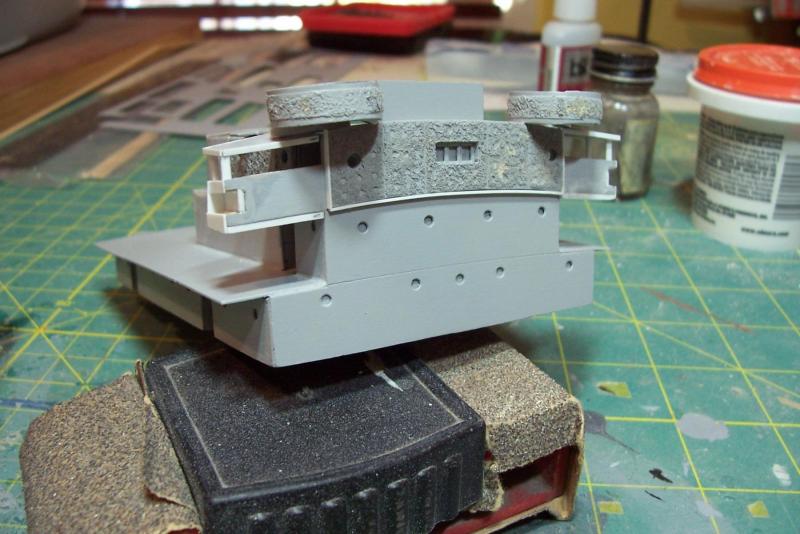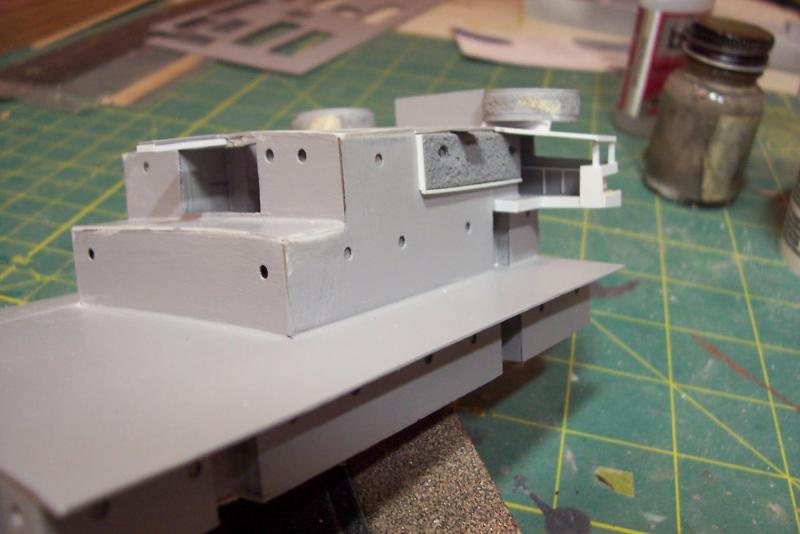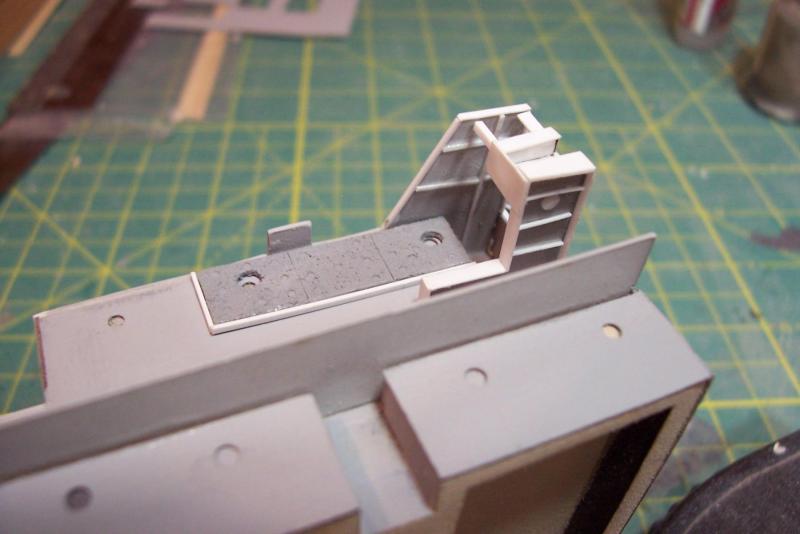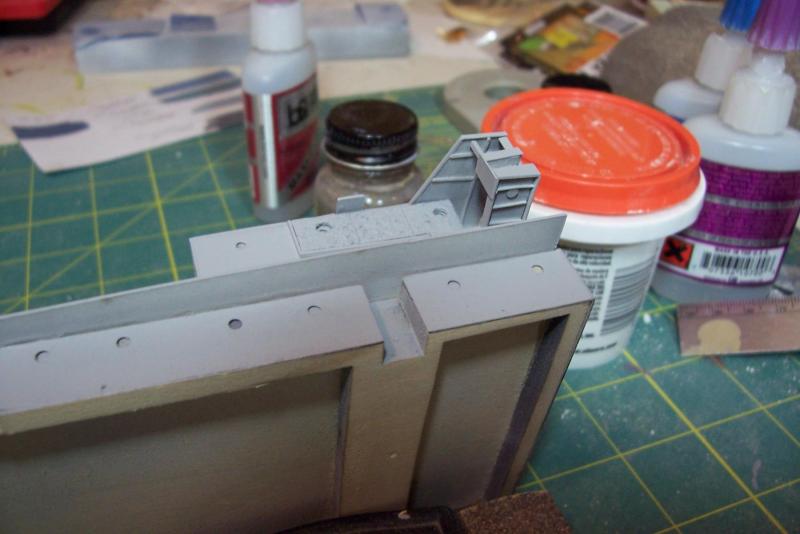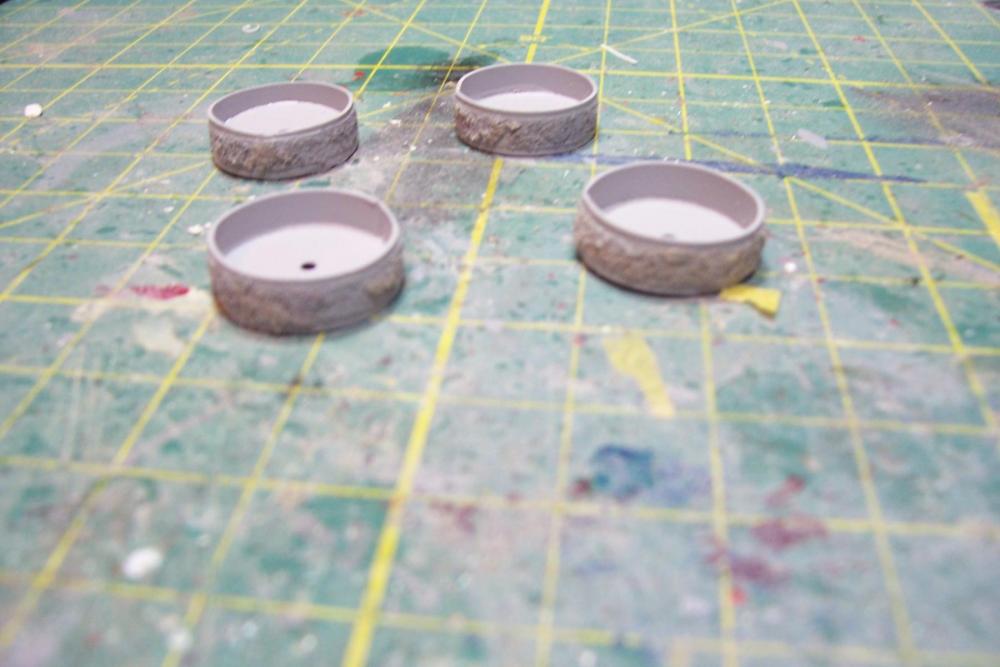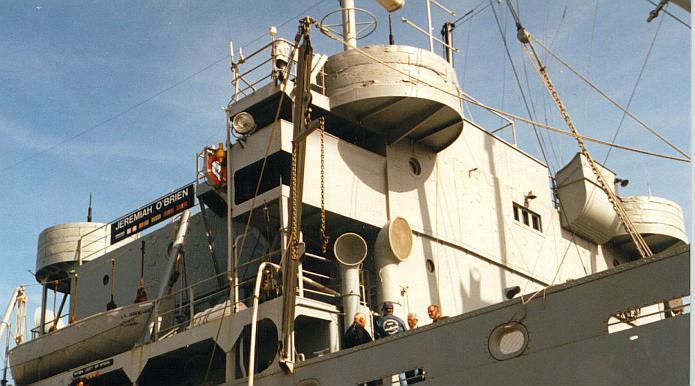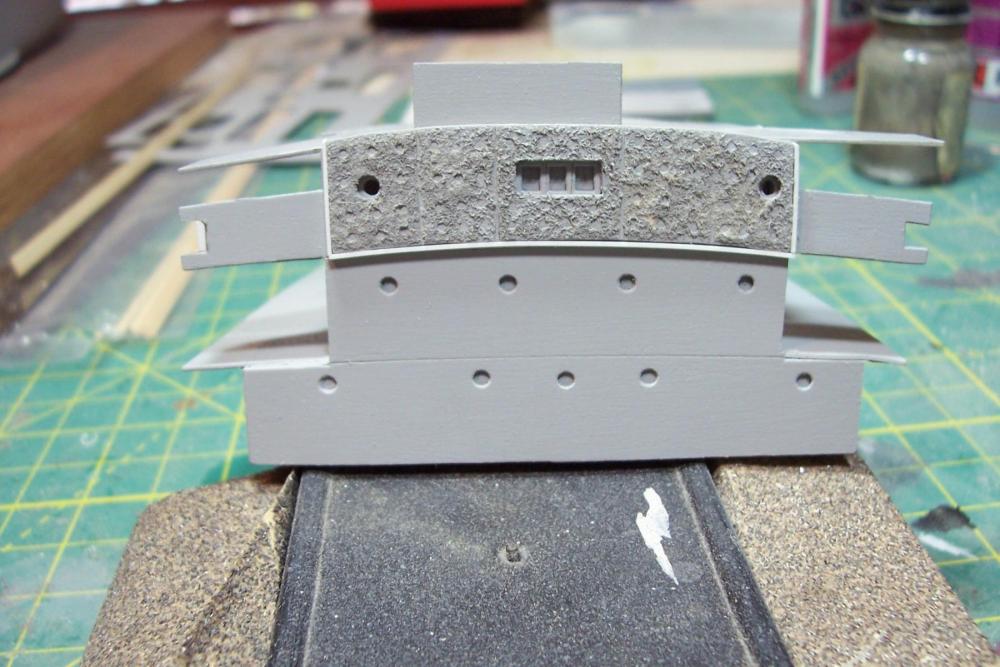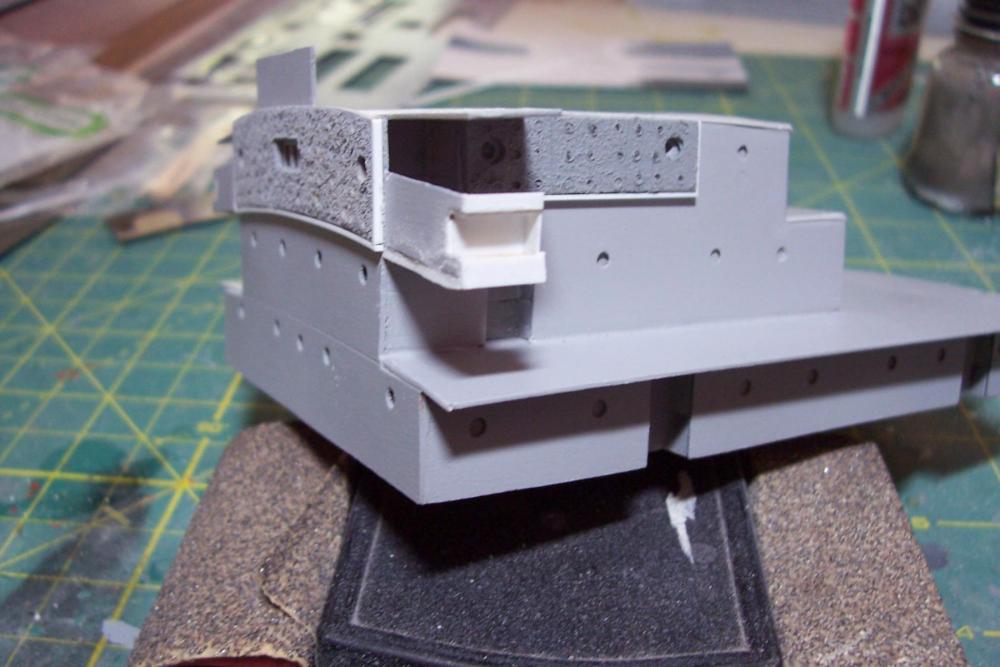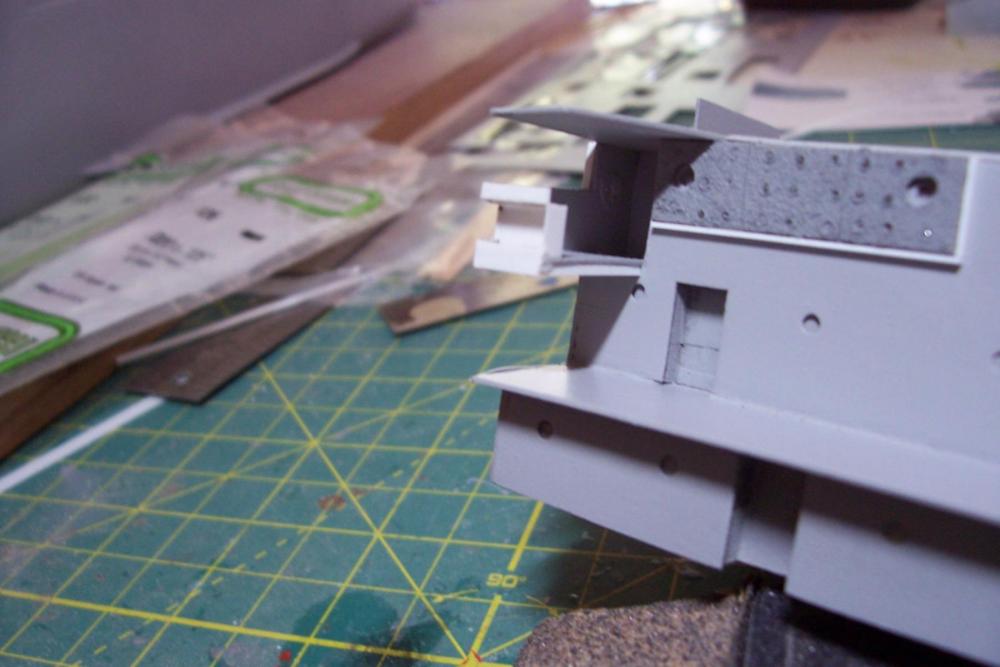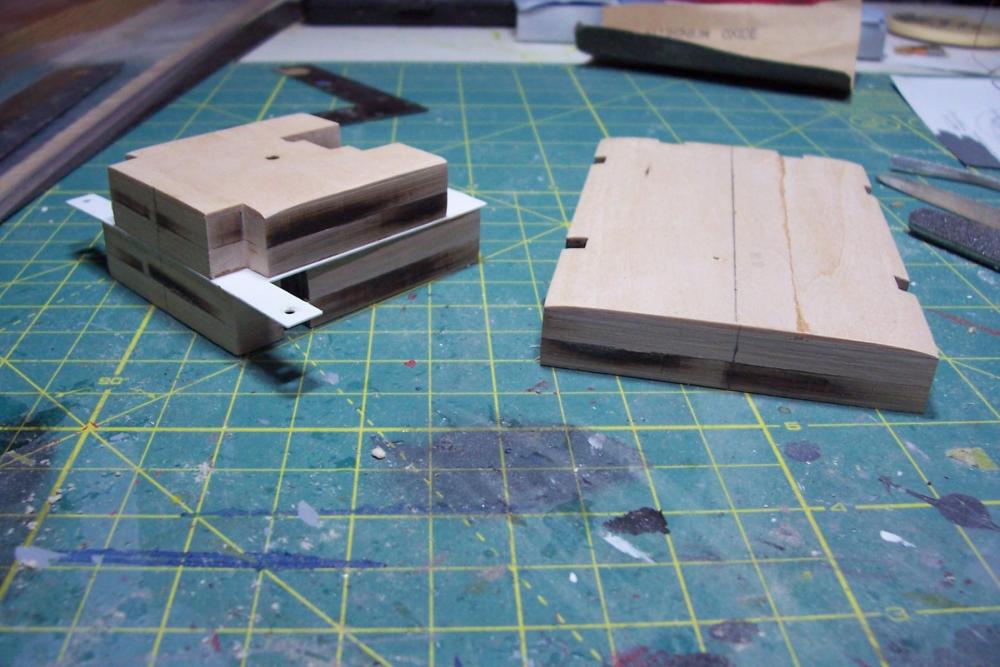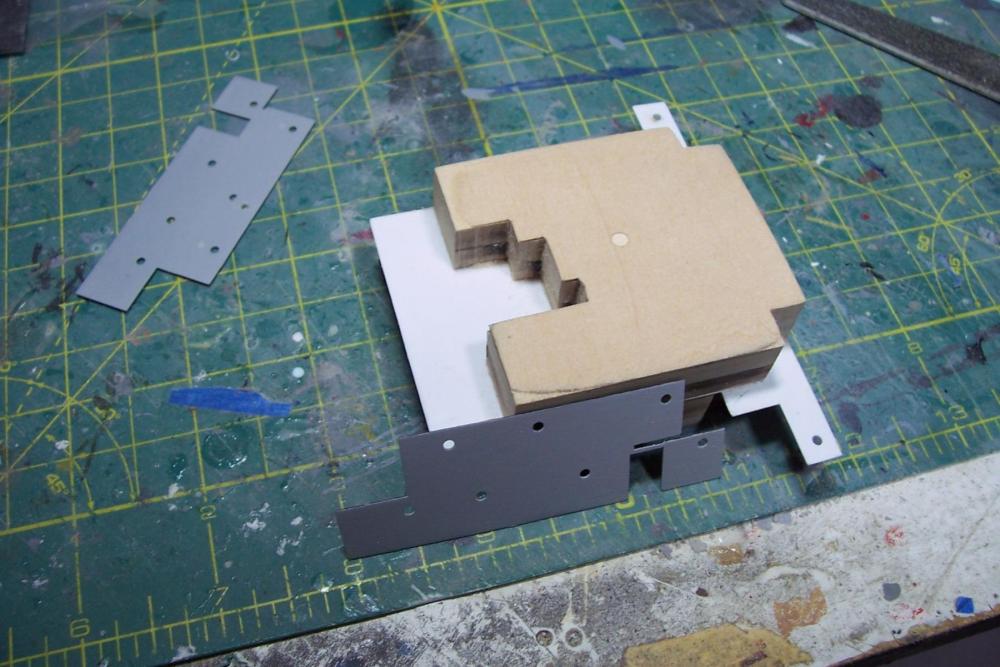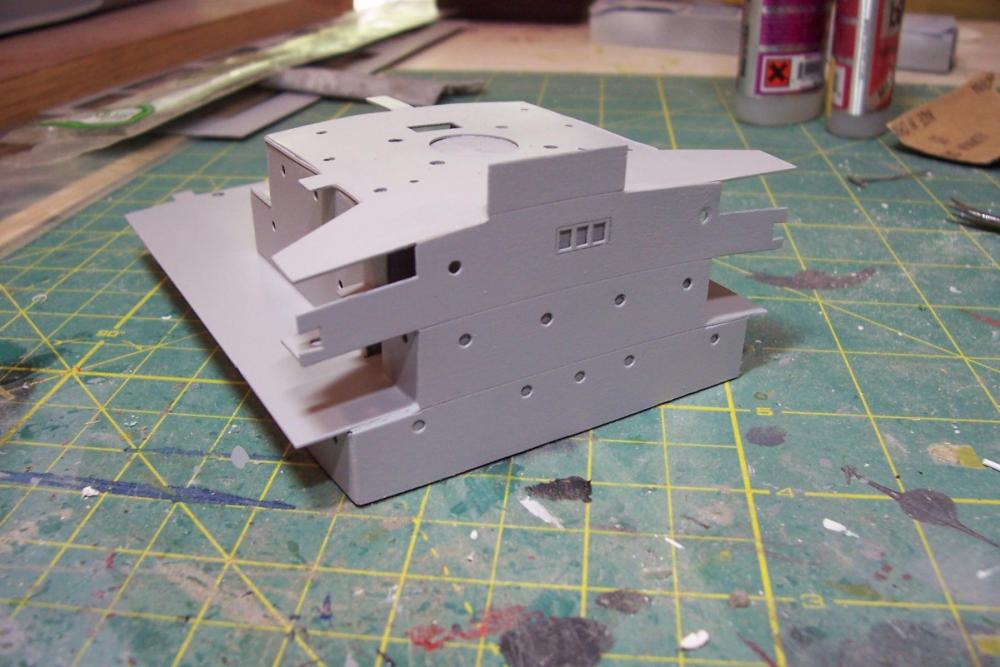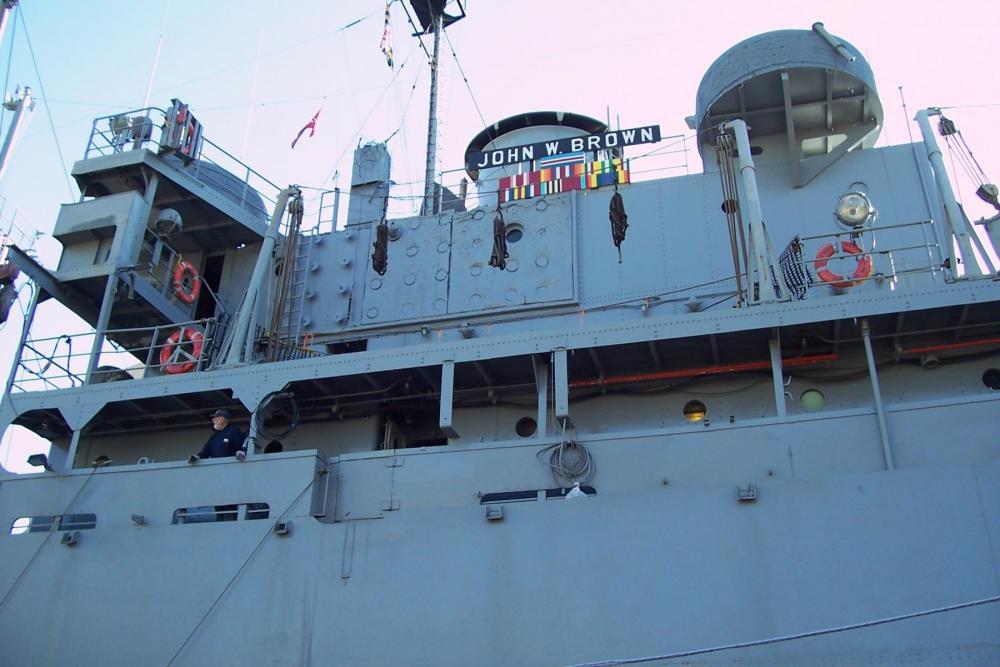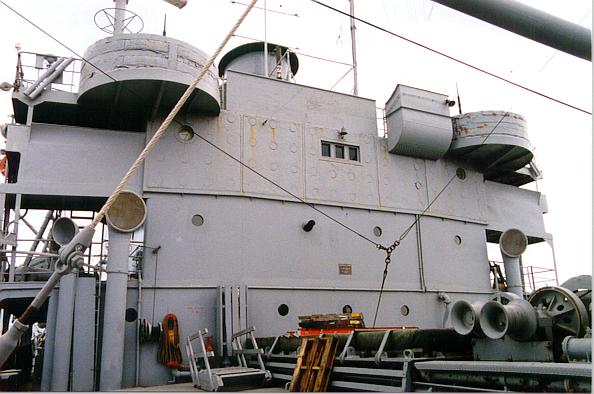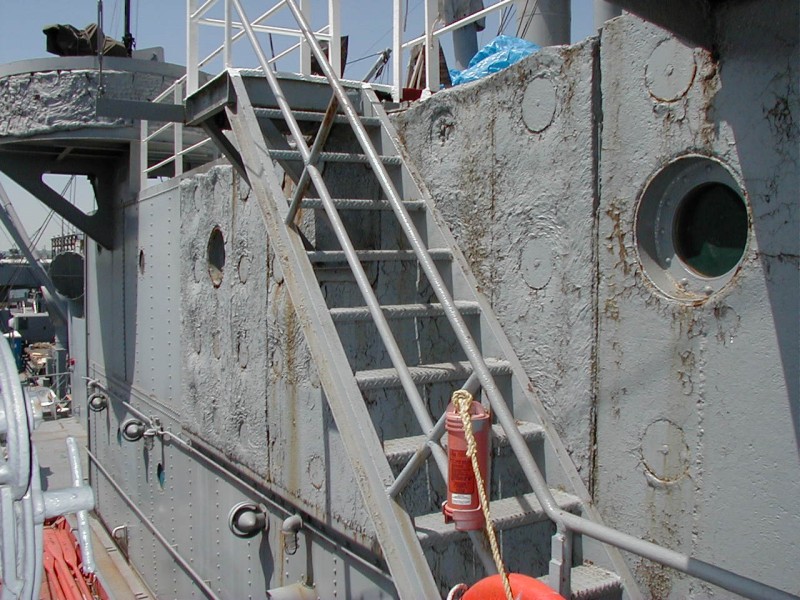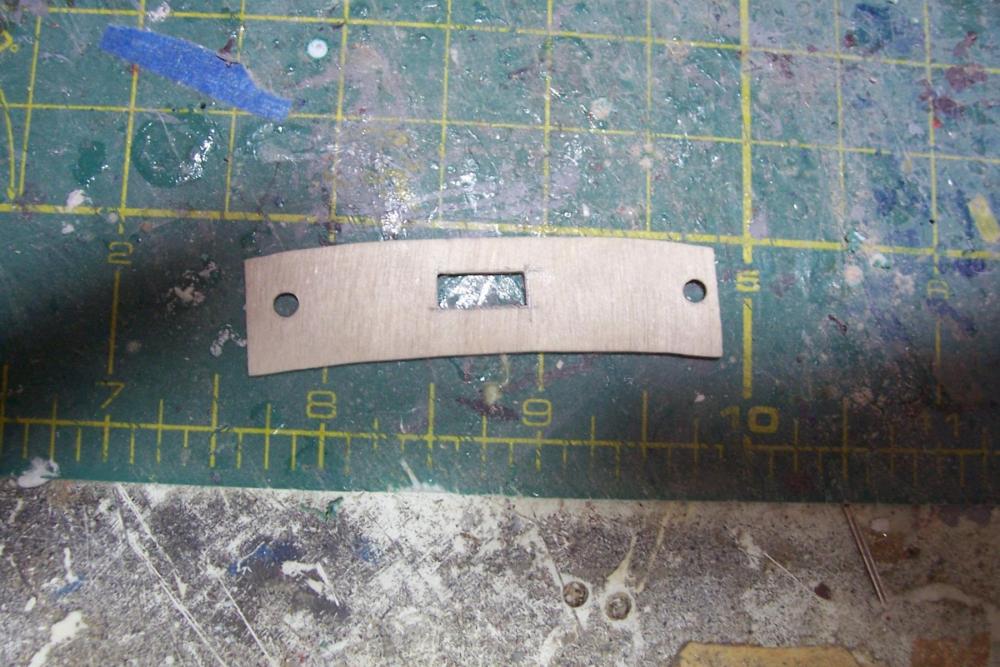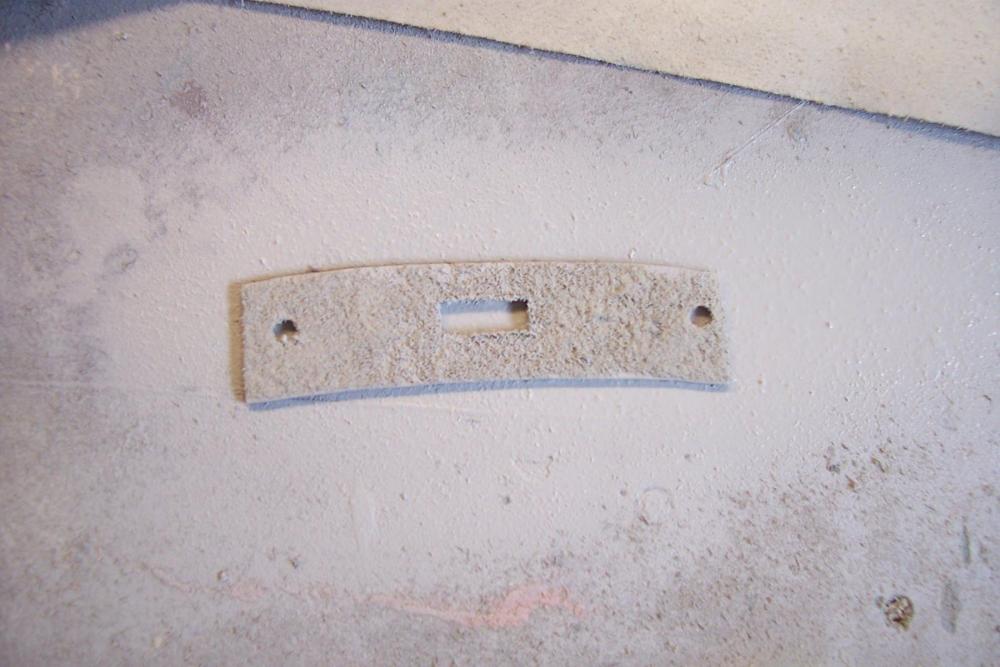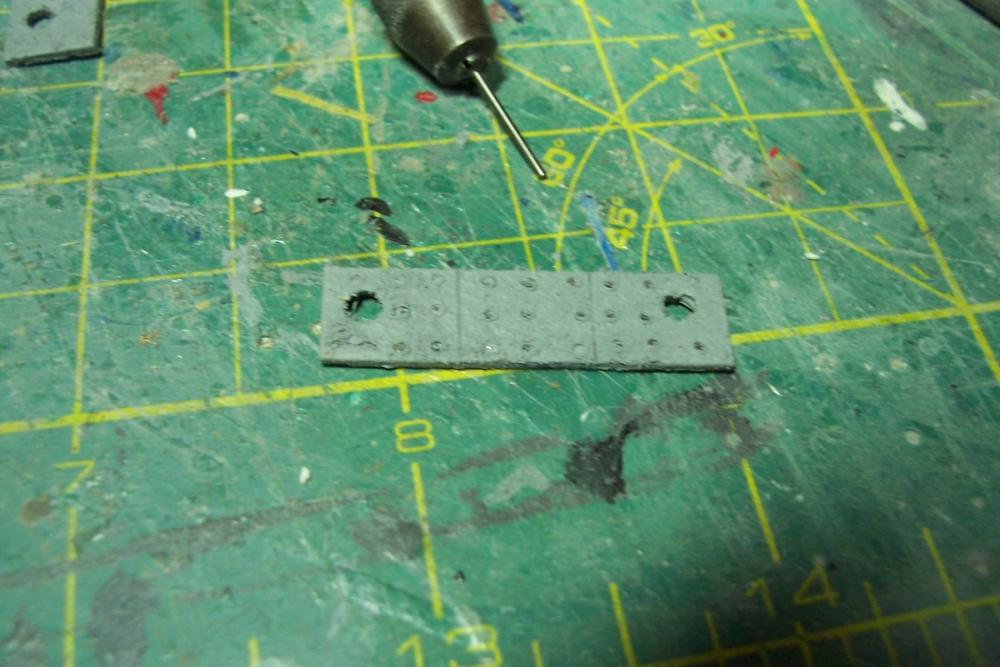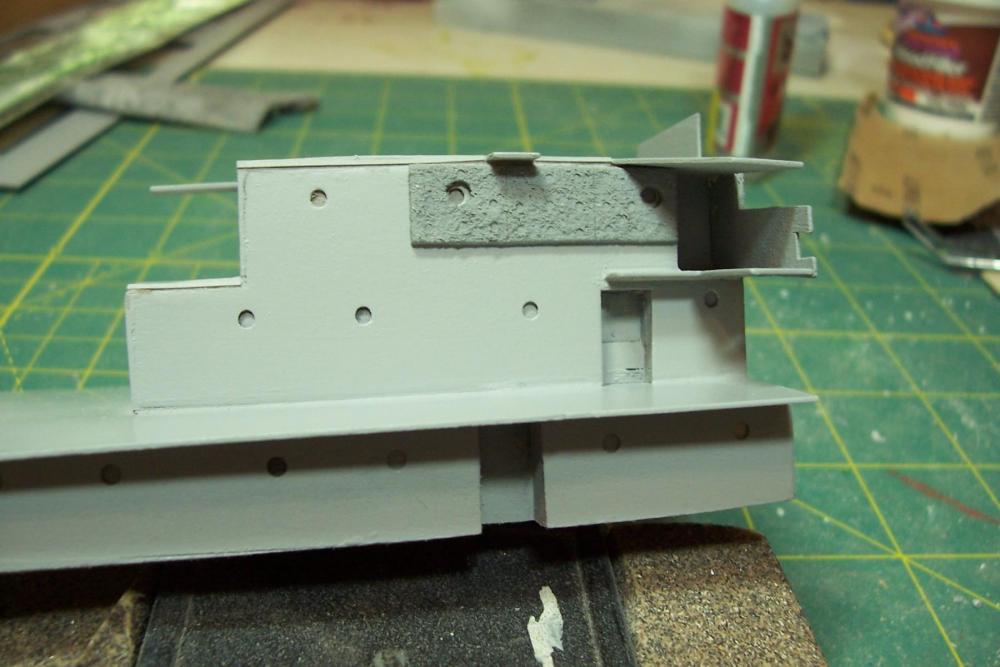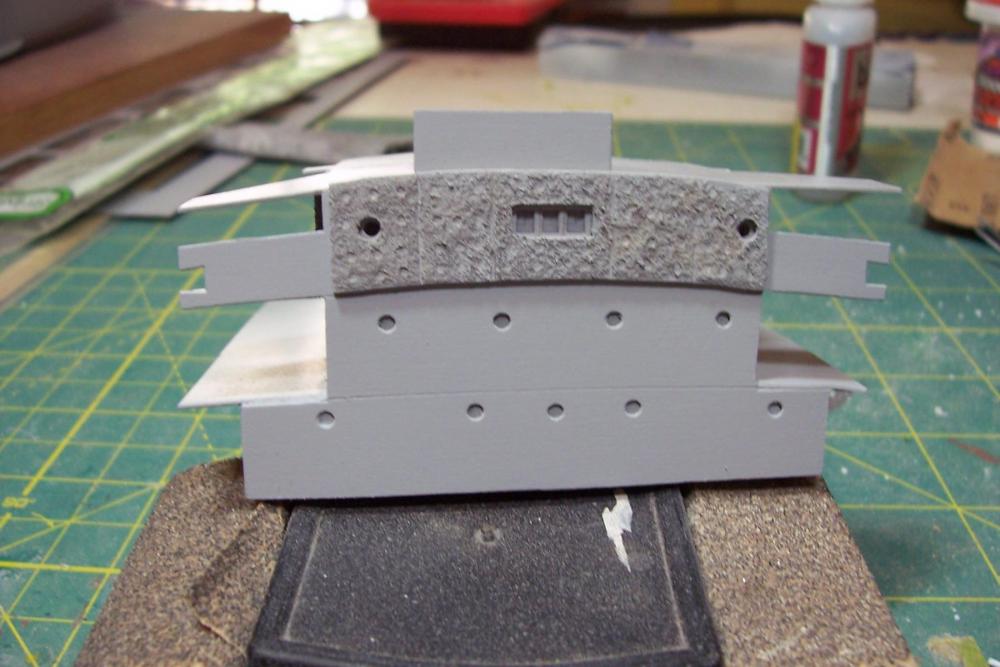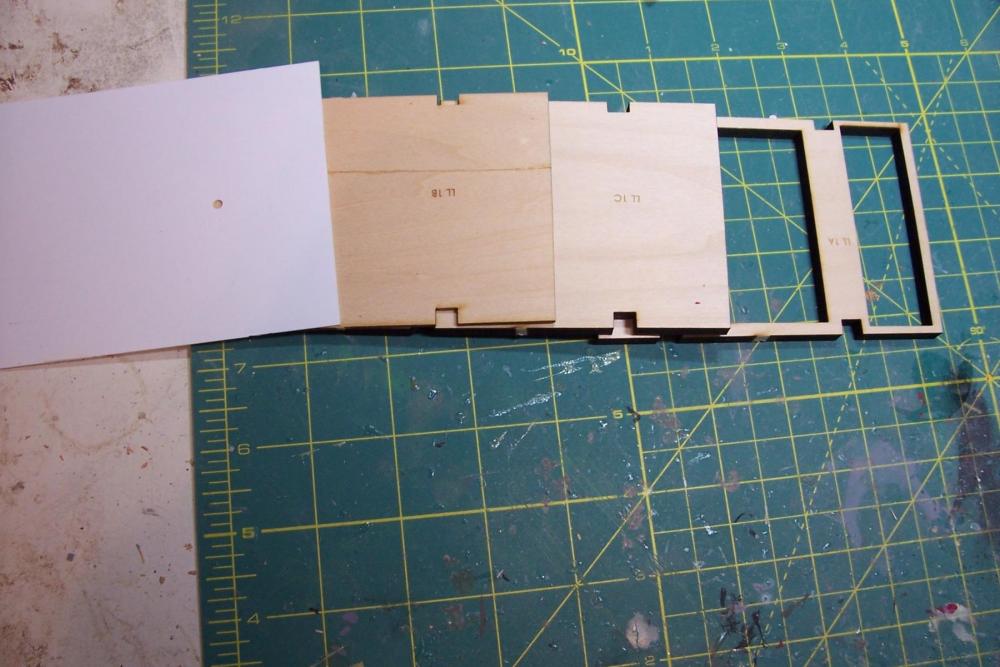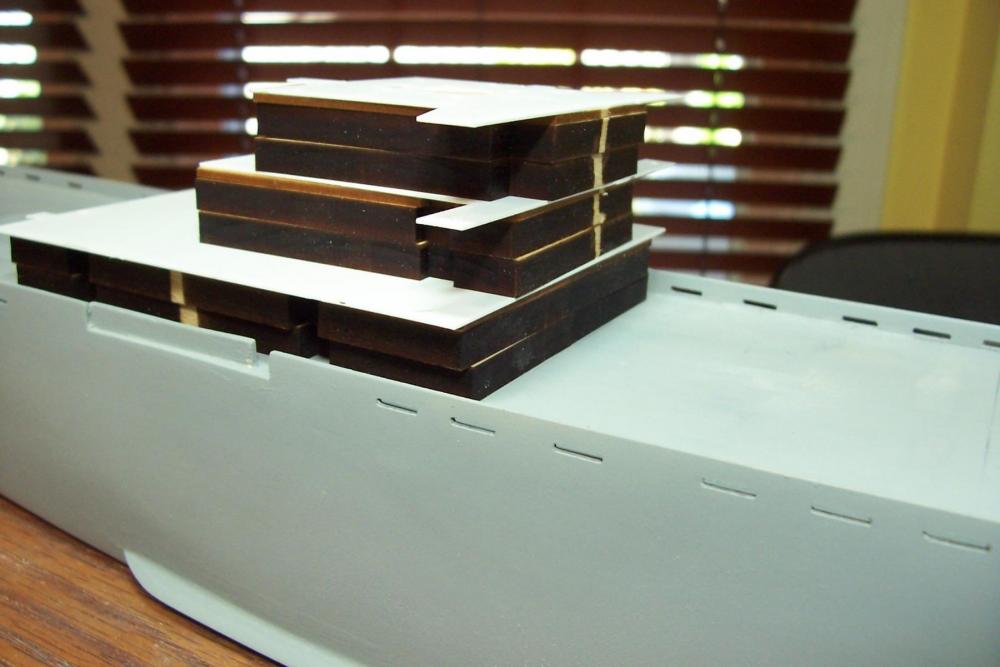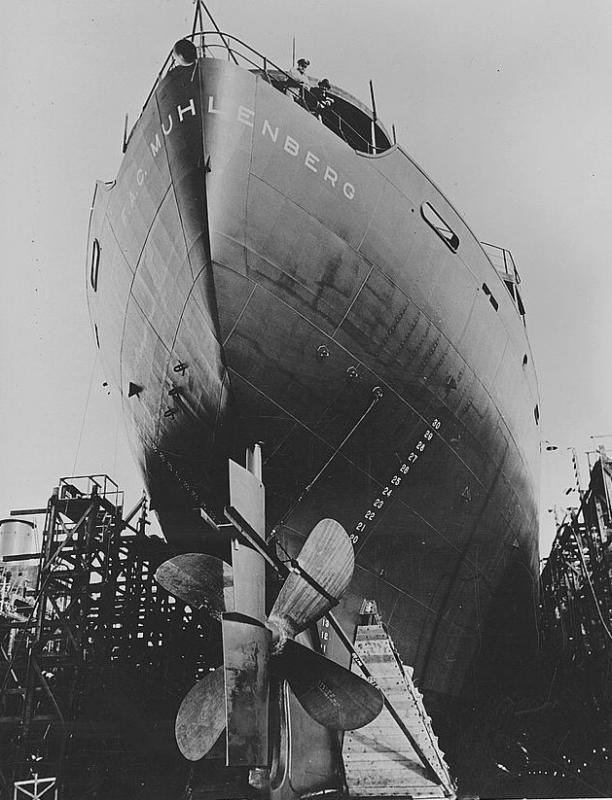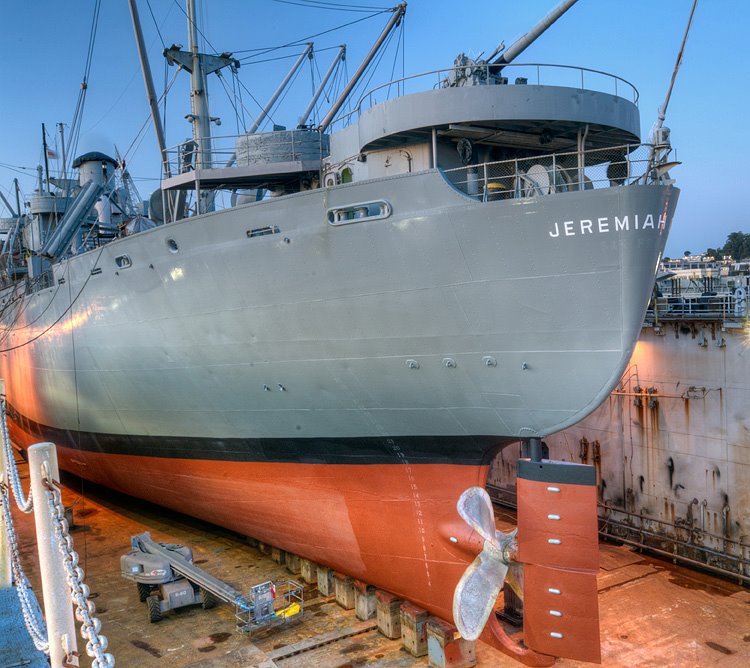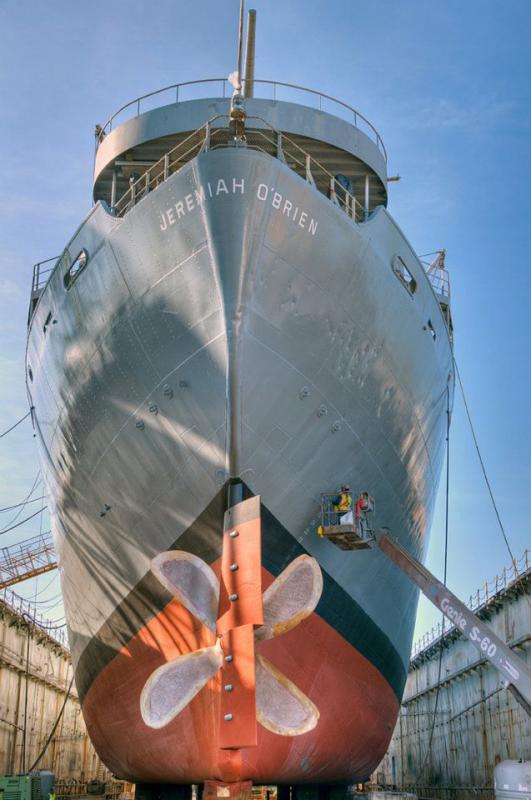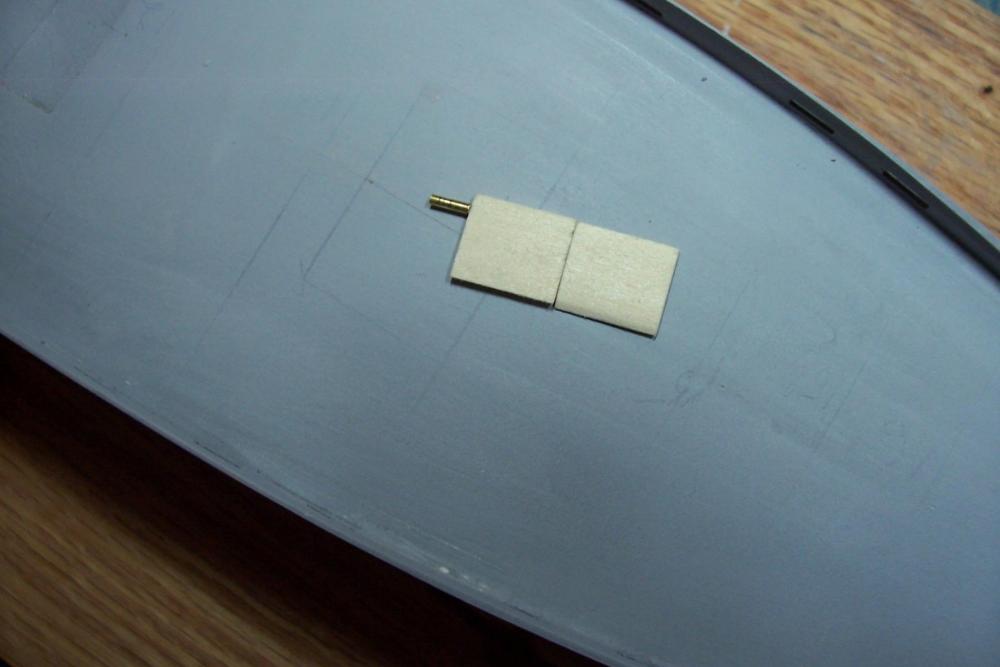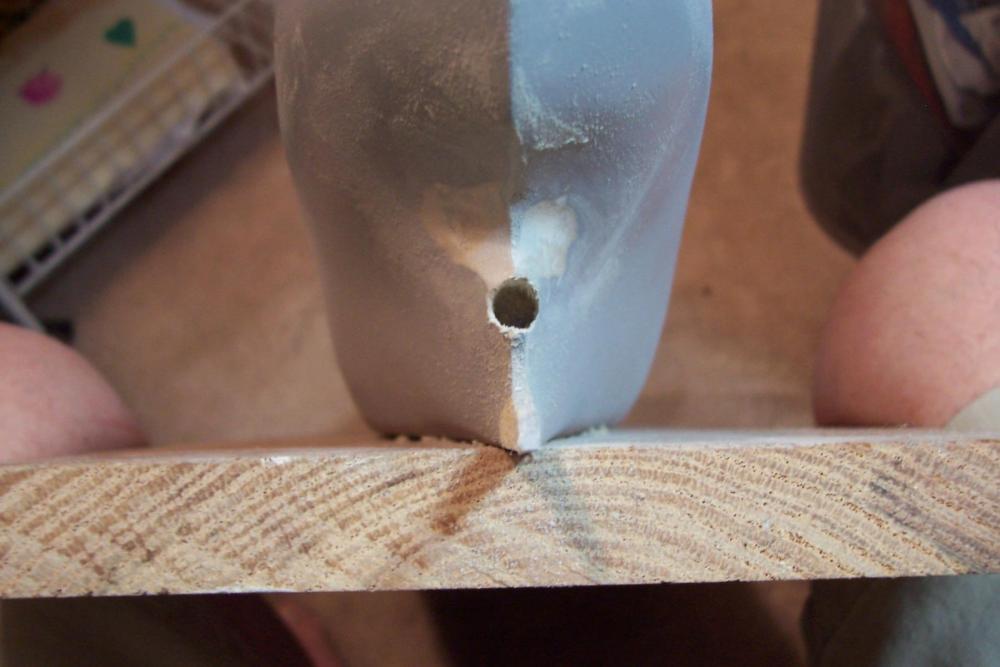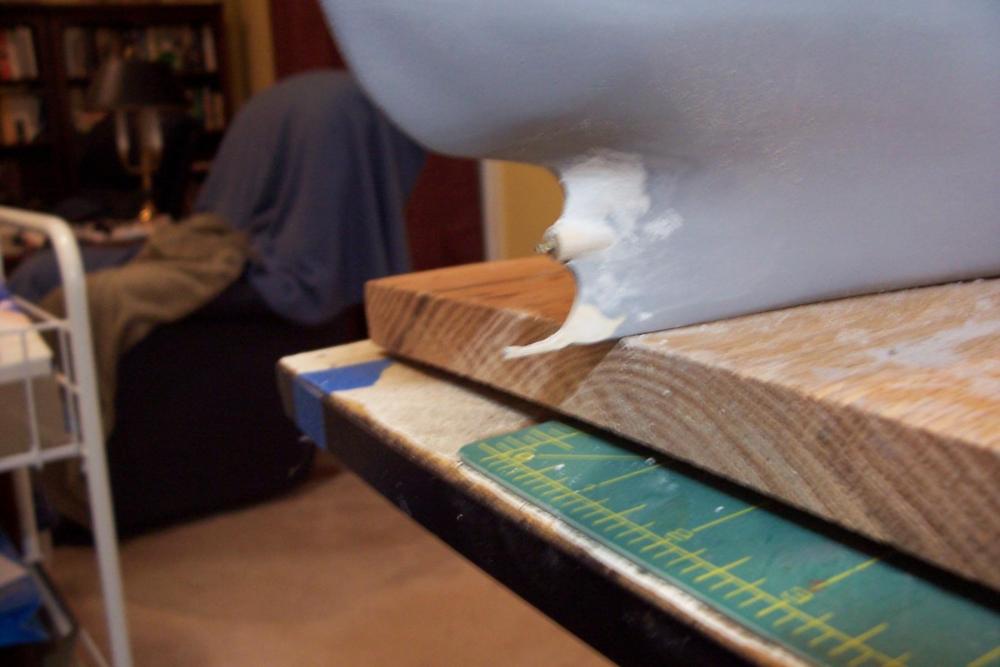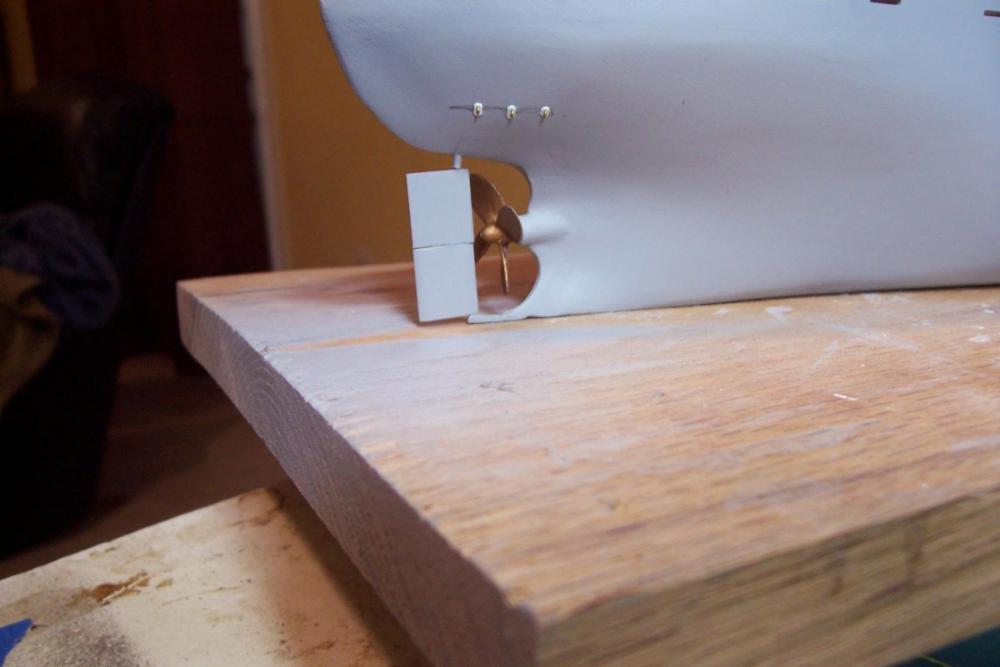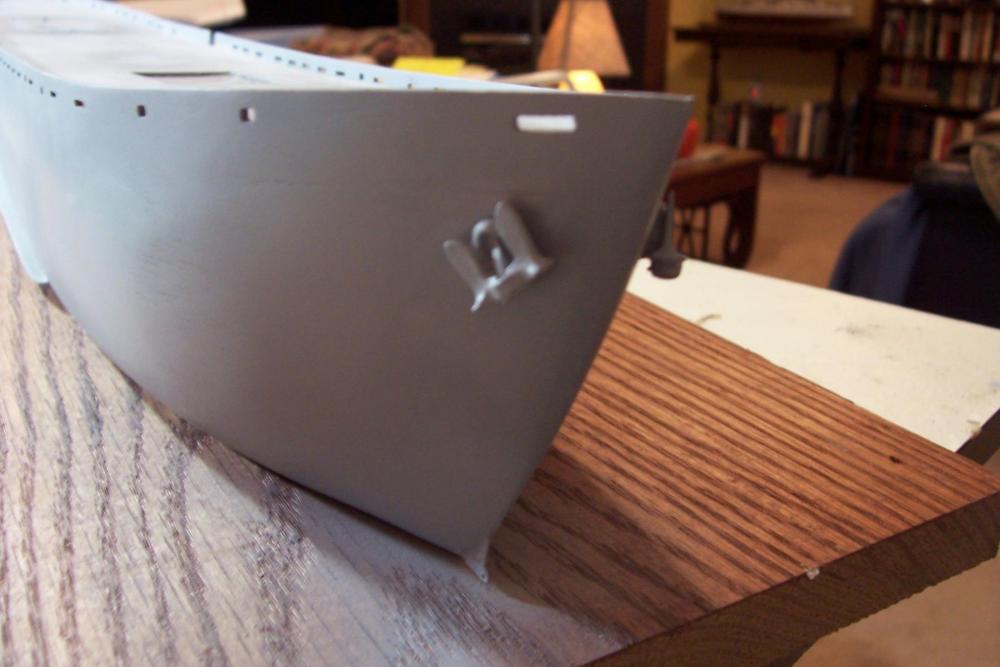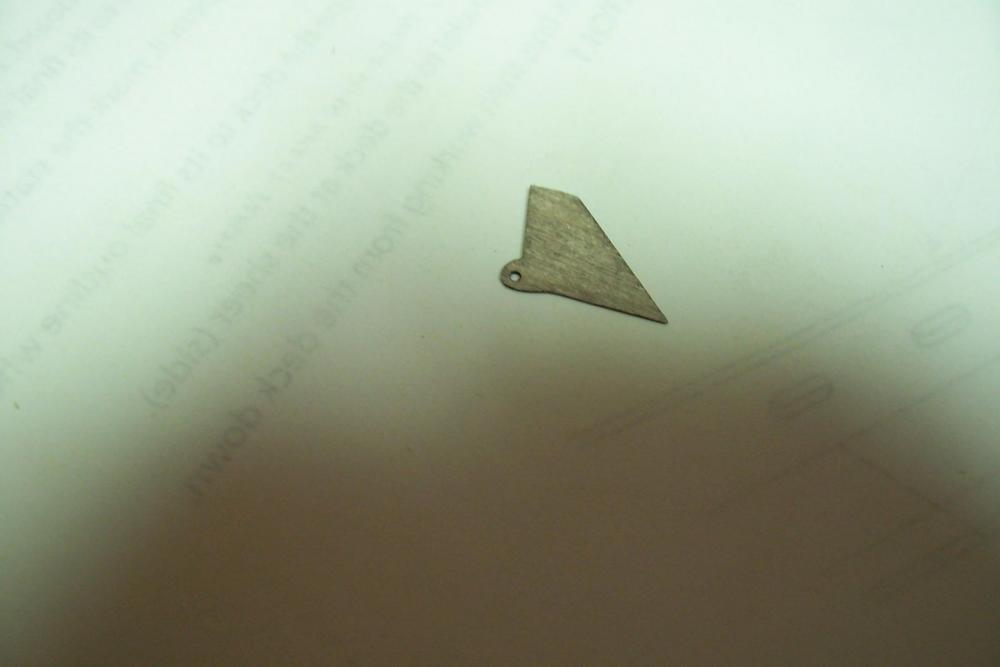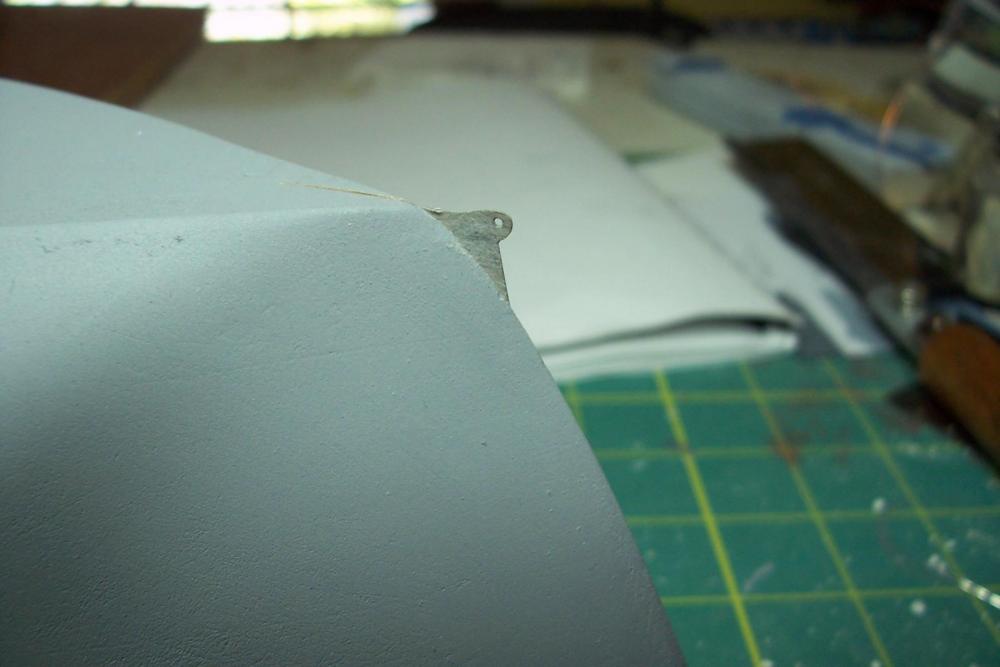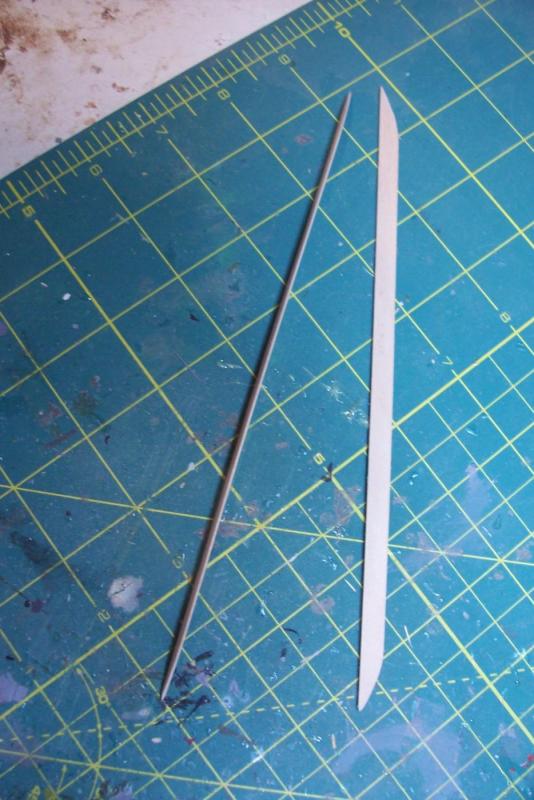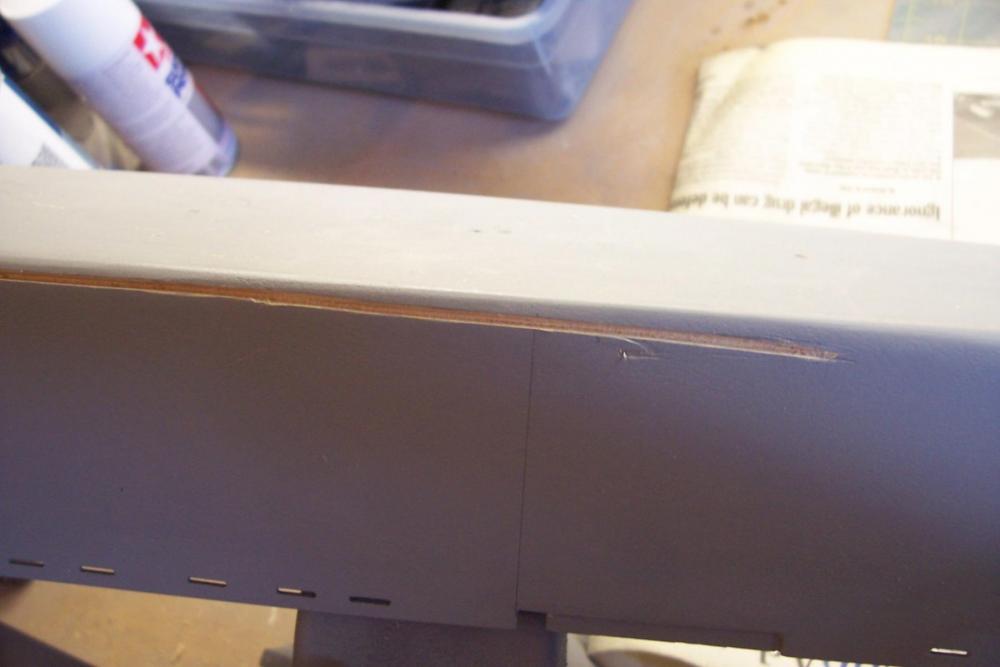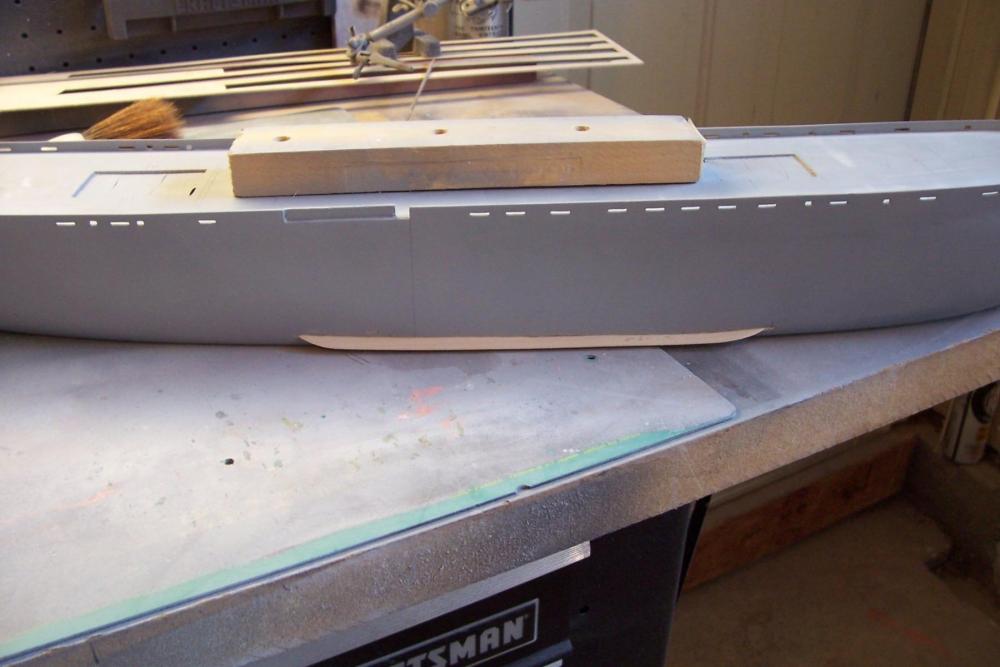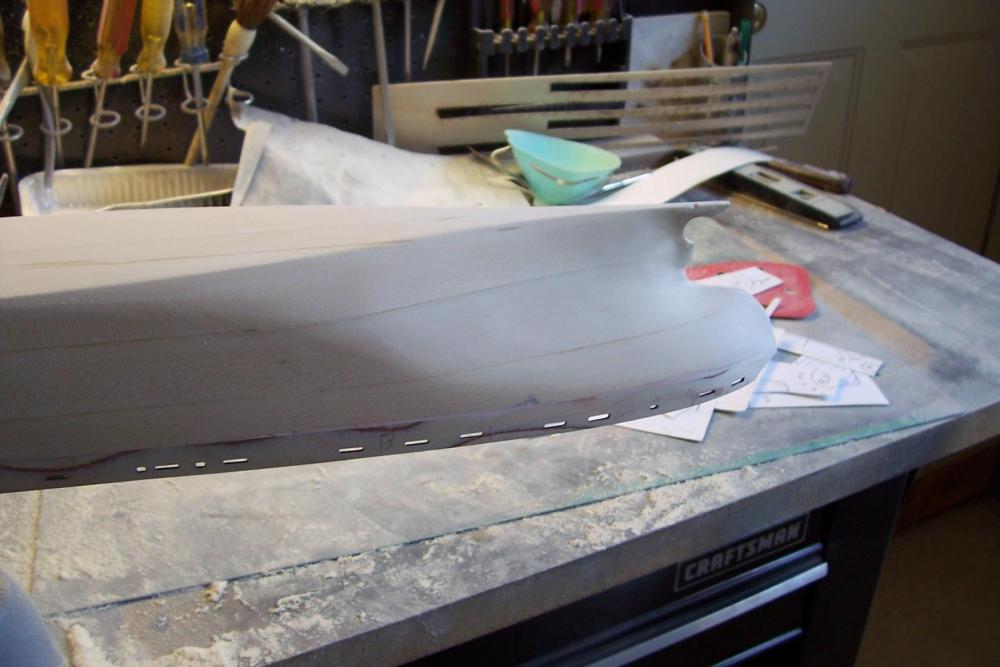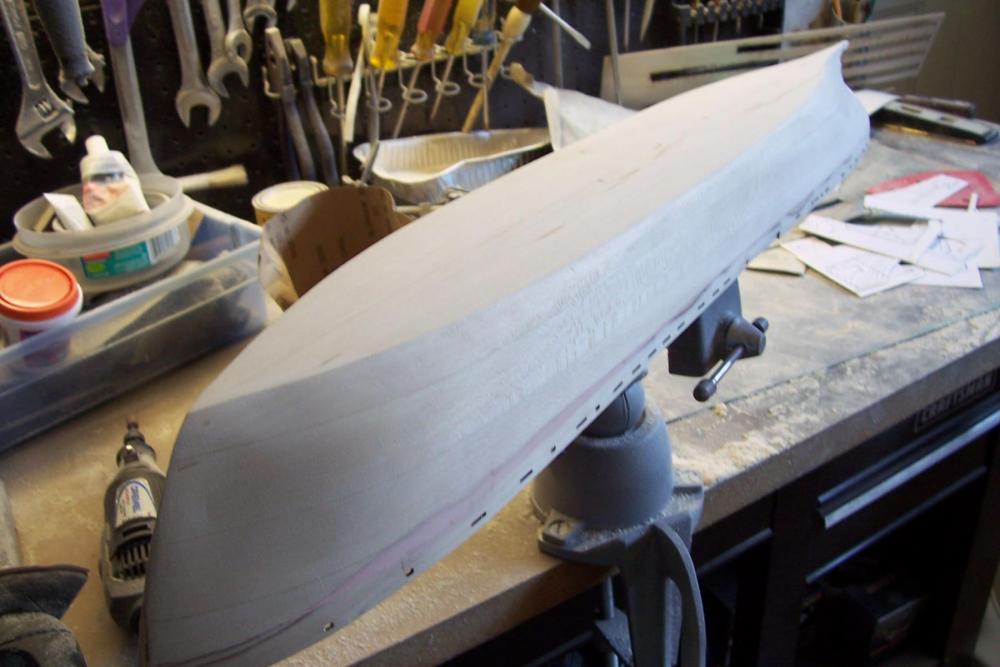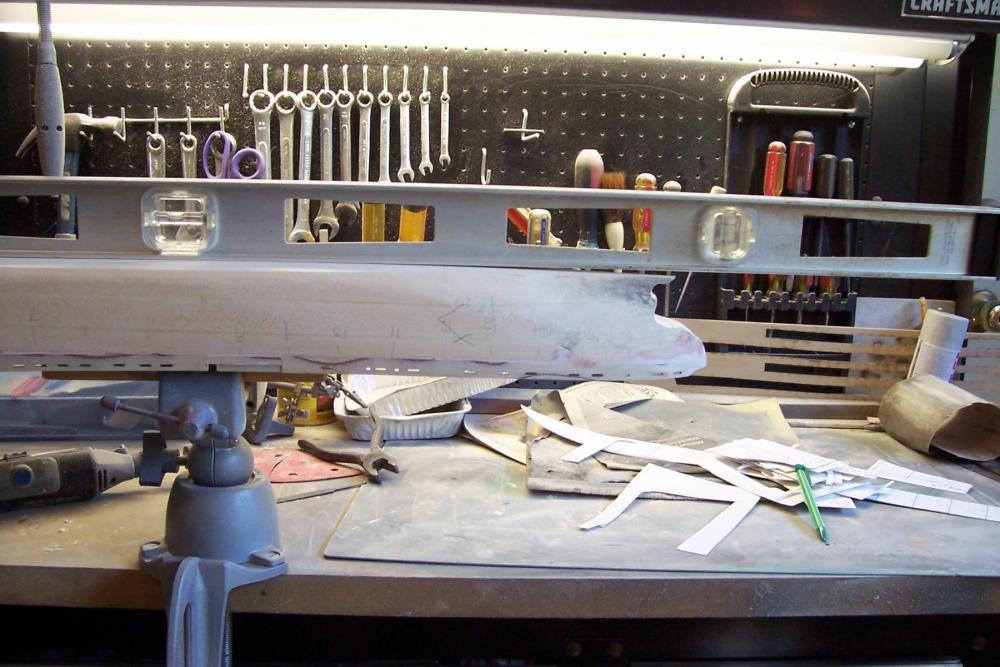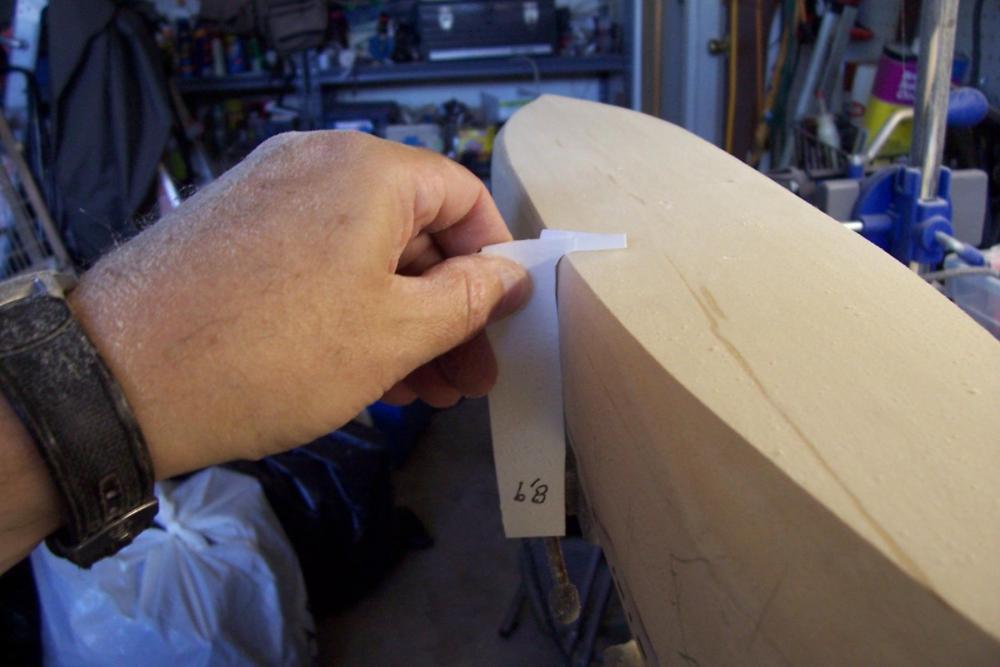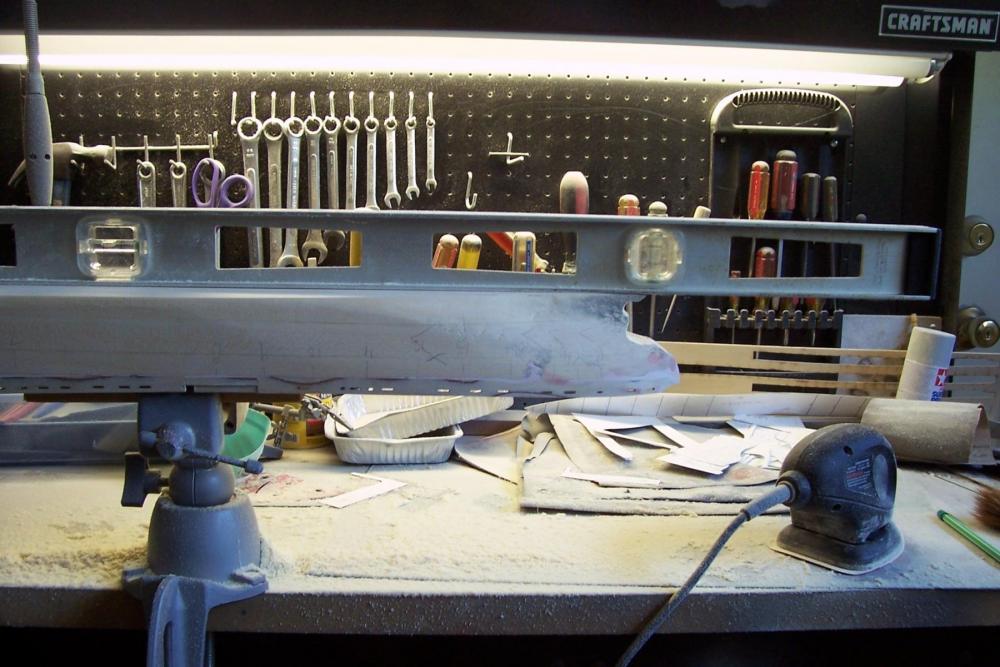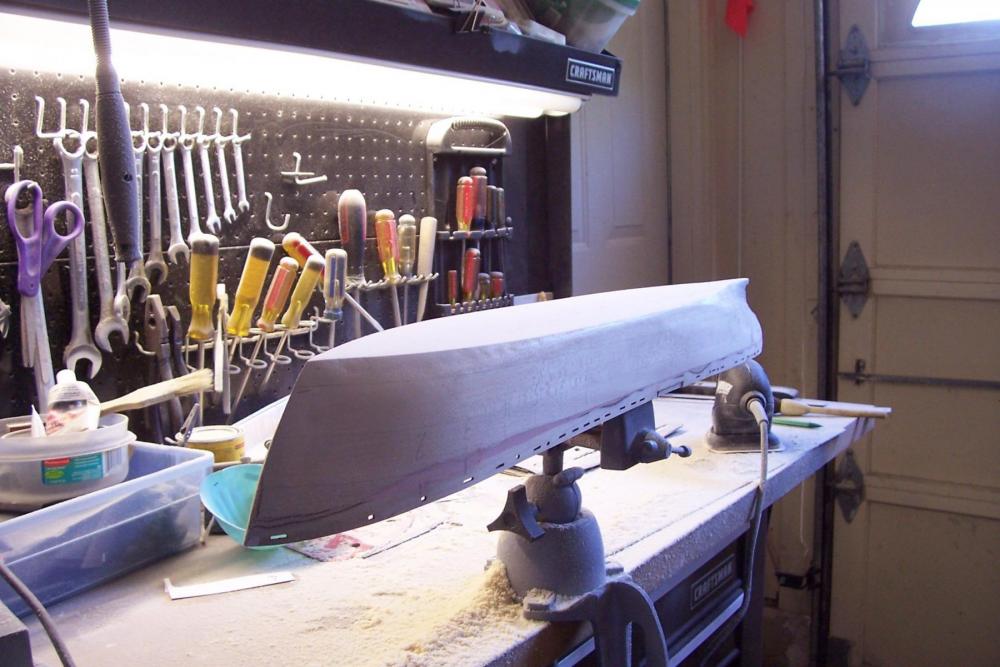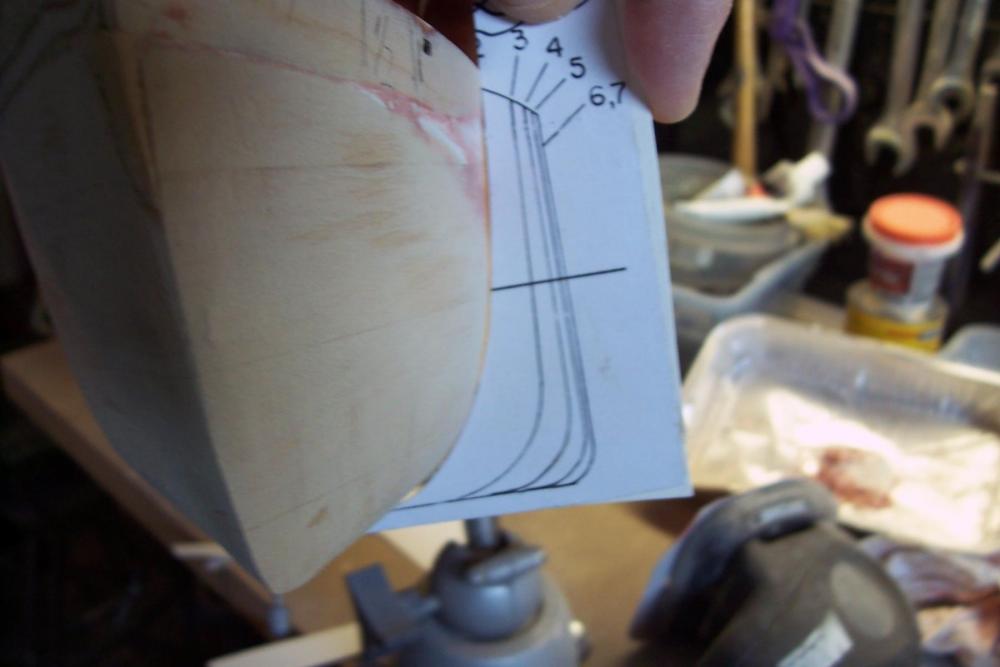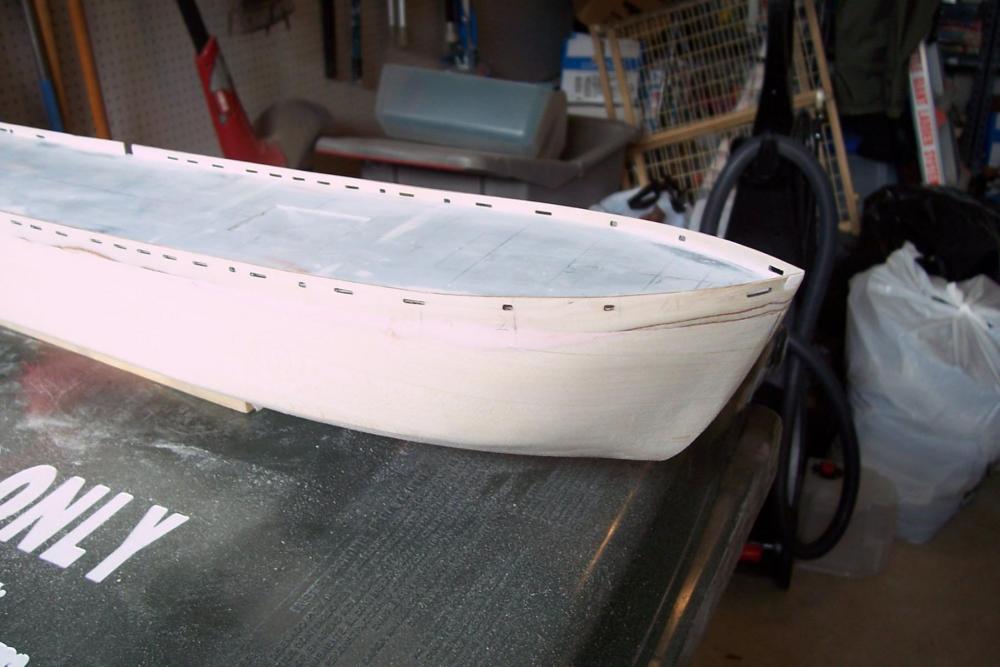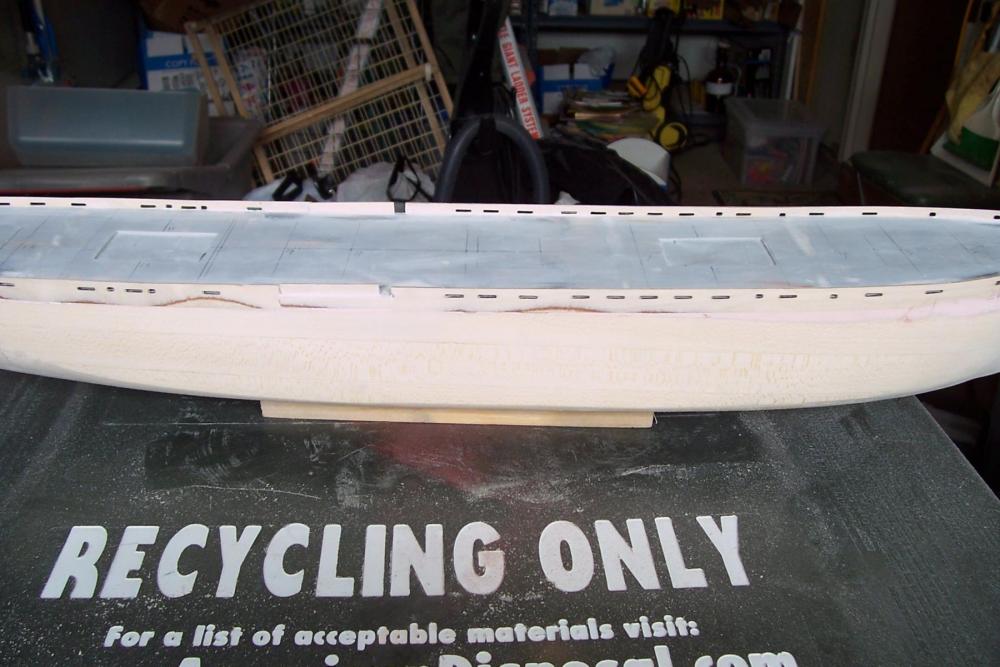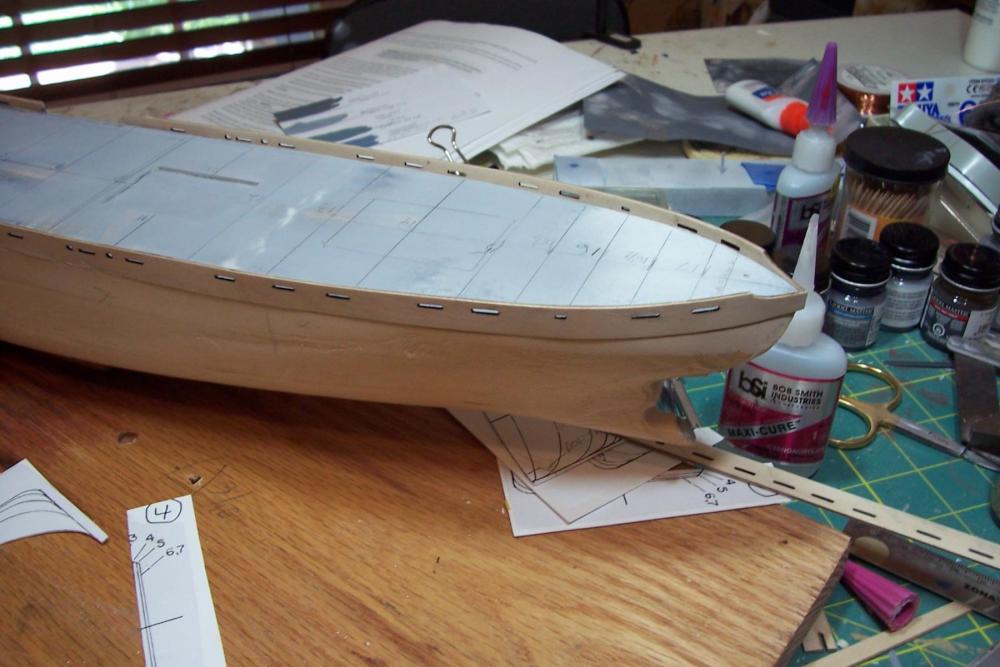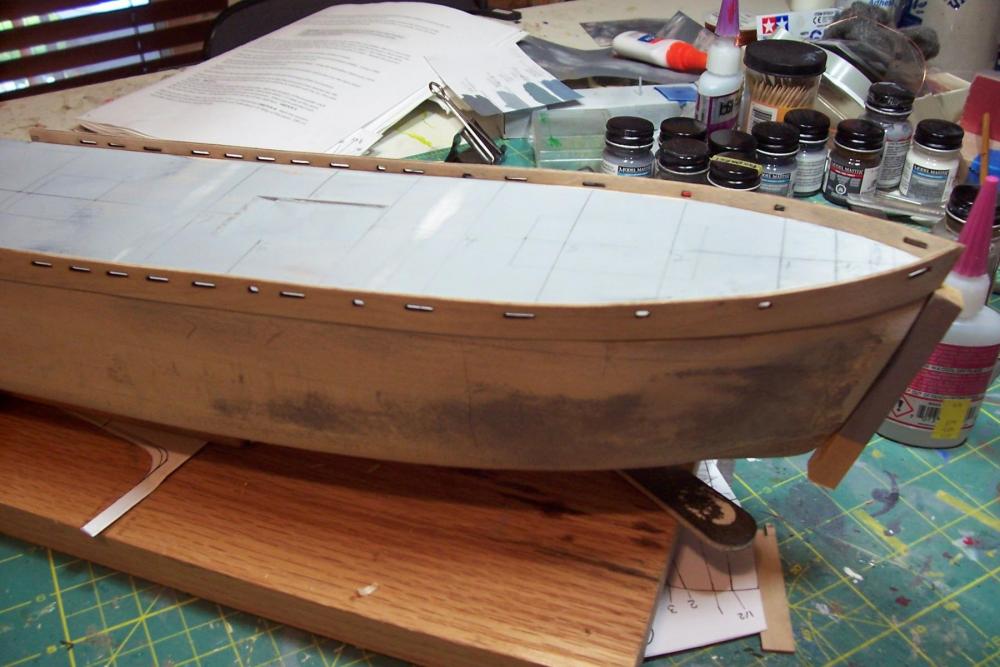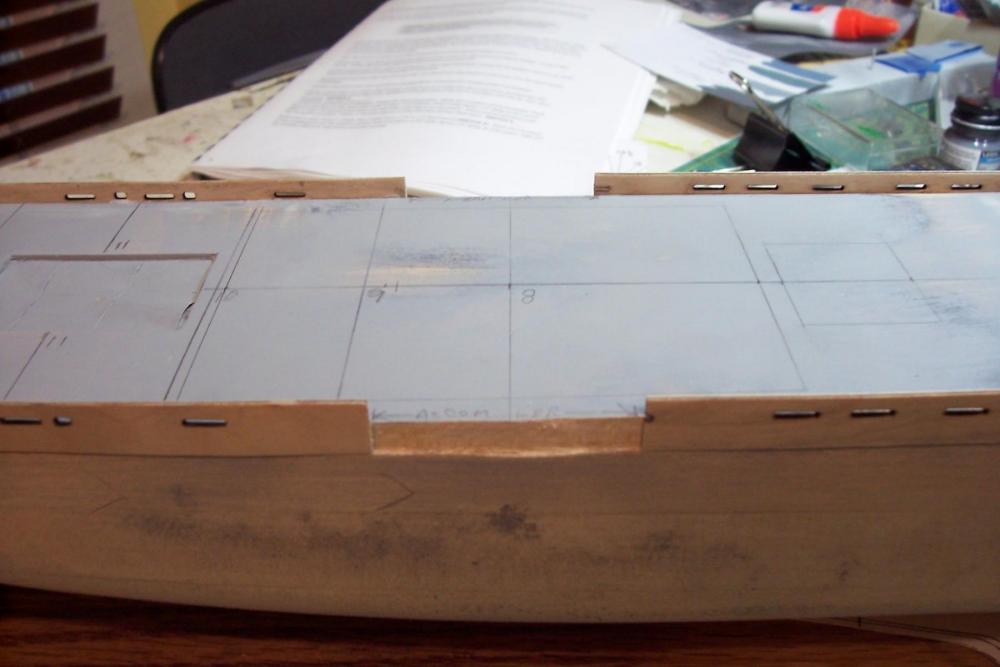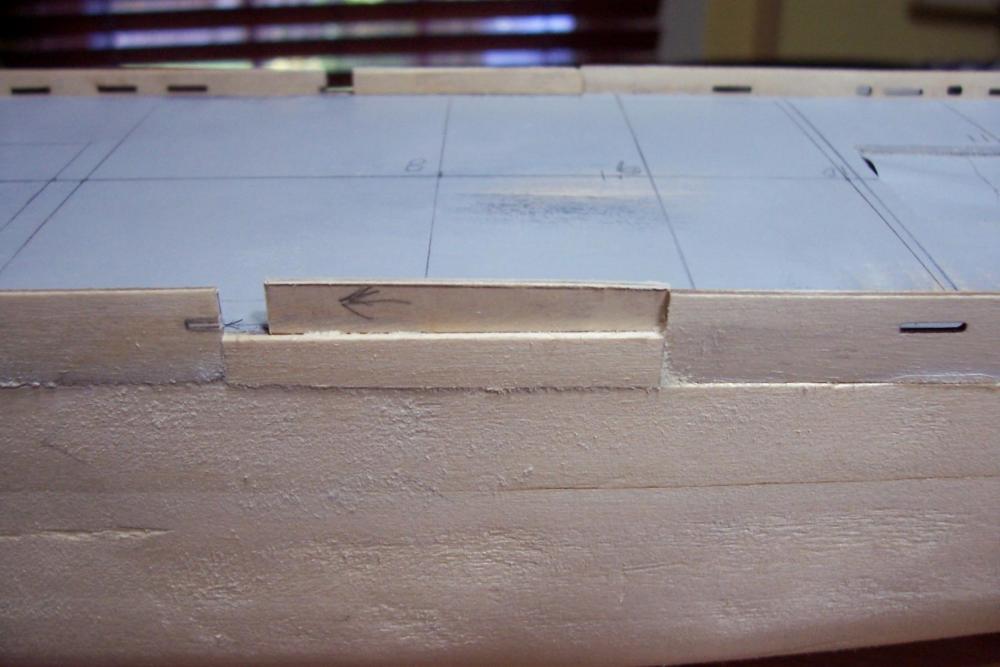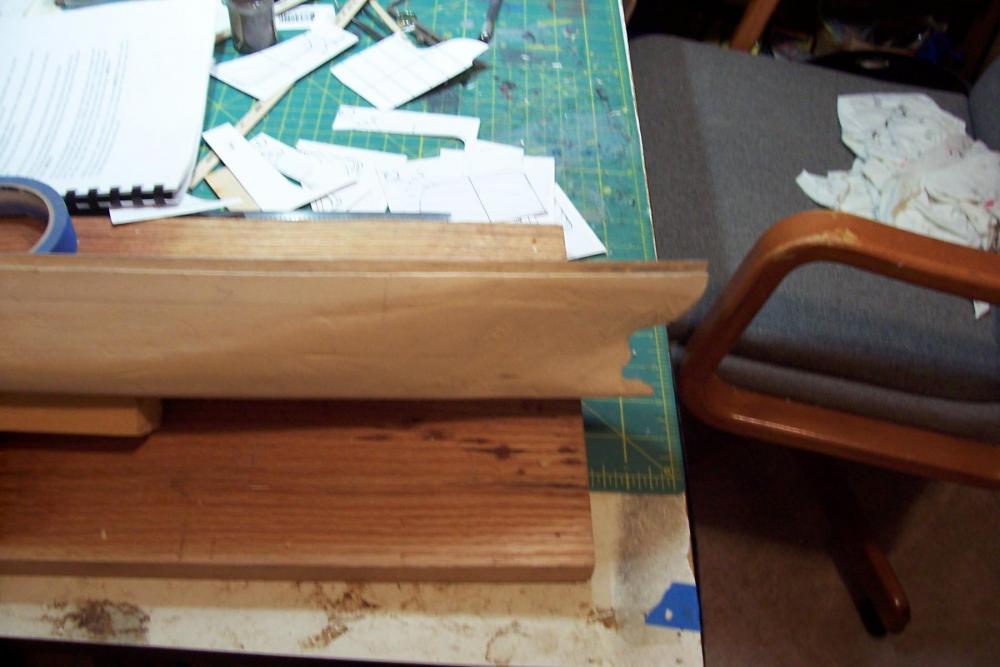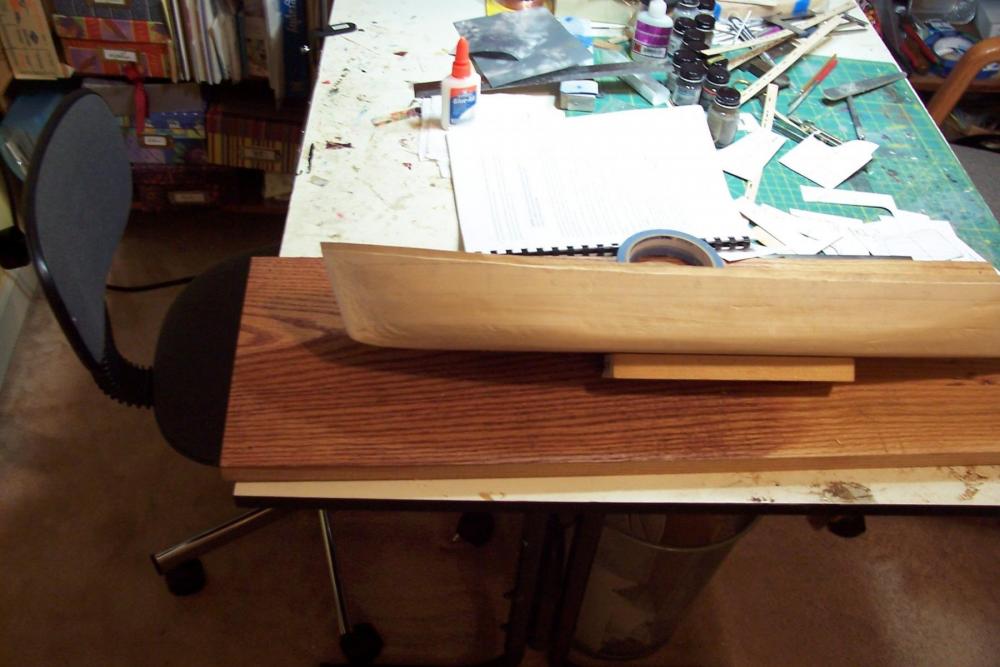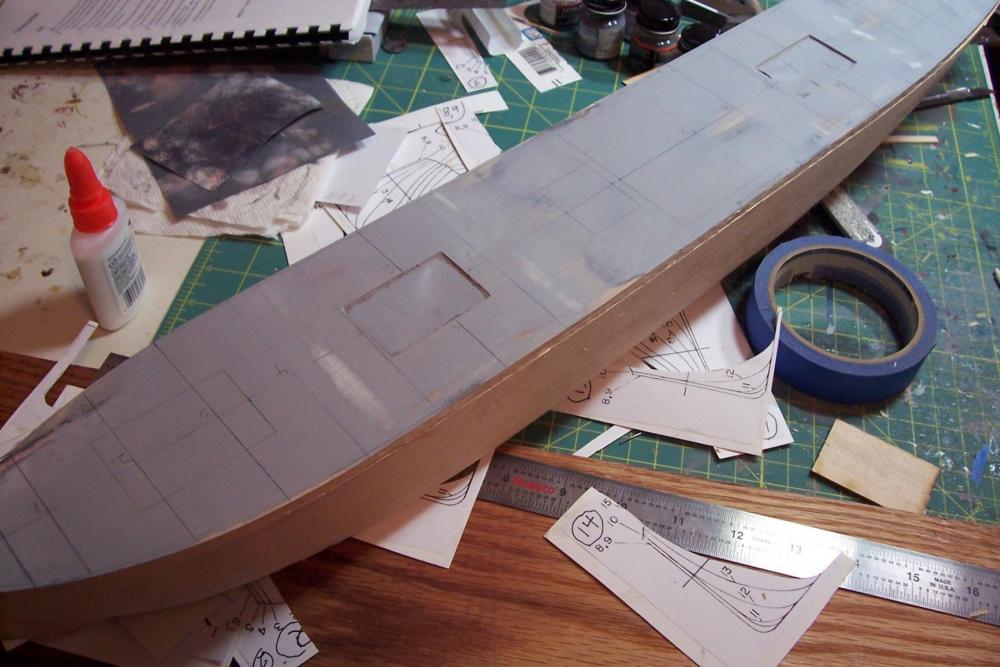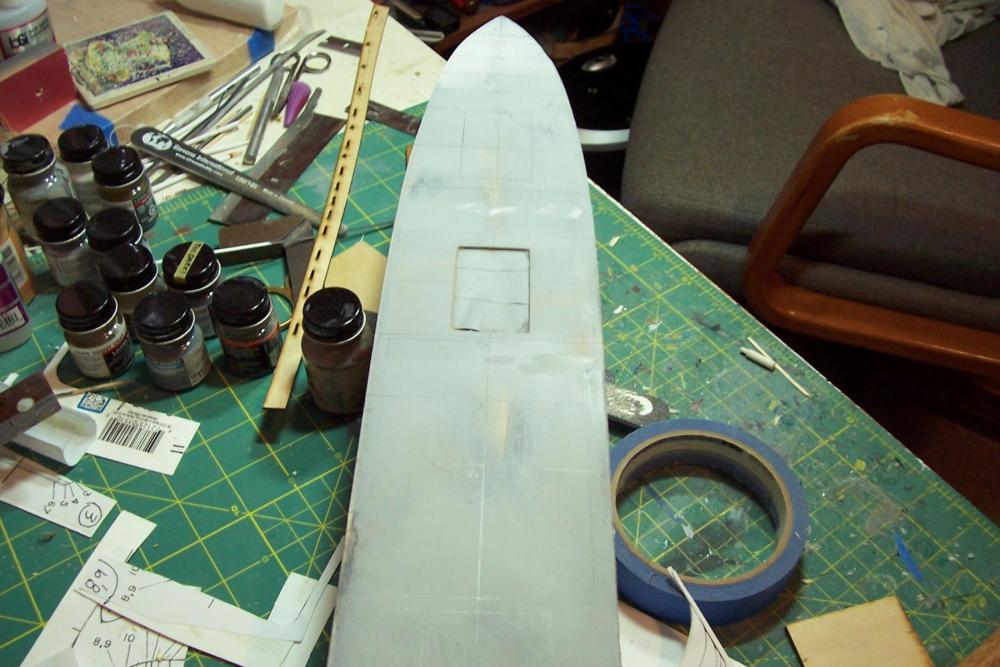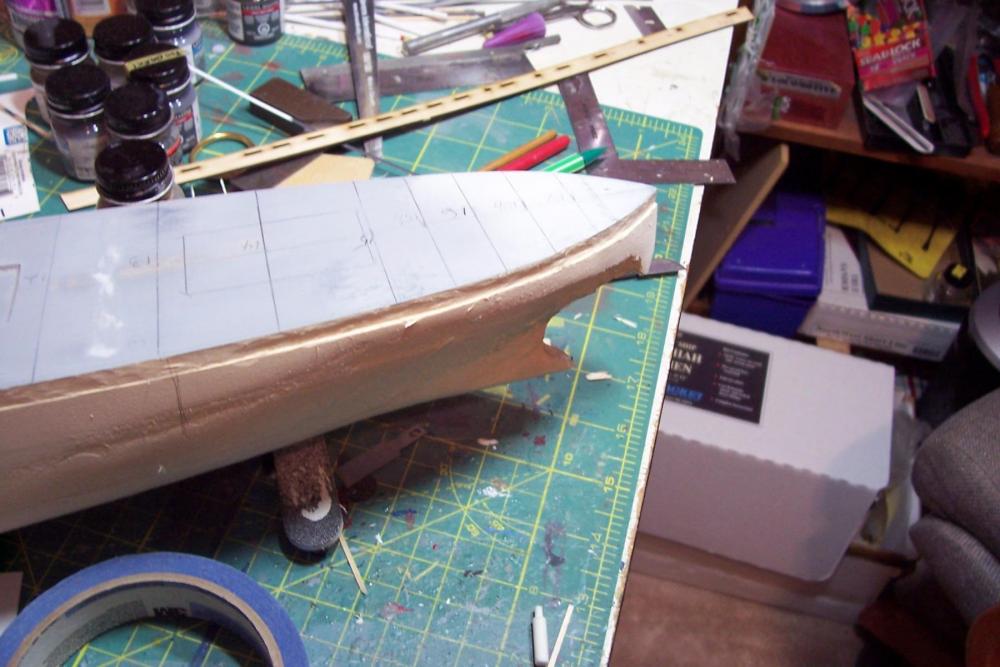-
Posts
645 -
Joined
-
Last visited
Content Type
Profiles
Forums
Gallery
Events
Everything posted by schooner
-
Deckhouse detailing It’s been fairly slow going adding detailing along the upper deck edges and stiffeners under the upper deck projections as well as completing the sidelight boxes and adding the forward gun tubs. I’d planned on adding some details to the bridge wings but after looking at photos of all 3 surviving Libertys I realized that compared to Navy ships they had virtually nothing in the way of rudder angle indicators, pelorus’, sound-powered phone jacks, etc. After priming the main deckhouse it can be set aside for awhile and I’ll move on to the after deckhouse and the crane houses.
- 227 replies
-
- BlueJacket Shipcrafters
- Stephen Hopkins
-
(and 2 more)
Tagged with:
-
Welcome aboard John. I had a similar experience with a mothballed destroyer when I was a kid in the early 70's . My friend's family ran a tugboat company and was hired to tow it to the scrappers. We were able to spend most of a day on her during the tow. EVERYTHING you can imagine was carefully packed away onboard including a full machine shop with tools, wardroom china (no silver though), damage control gear, linens, etc. Just about everything needed to get her in service except beans, bullets and black oil. Tim
- 227 replies
-
- BlueJacket Shipcrafters
- Stephen Hopkins
-
(and 2 more)
Tagged with:
-
Deckhouse detailing Before heading off on a week and a half vacation there’s a little time for a little detailing. The gun tubs are made out of styrene and the plastic armor belt added: The deckhouse front facing piece on the kit provides cut-outs where the sidelights go and the plans show the box in which the lights sit but there is no material or mention of it in the instructions so I think it just fell thru the cracks. Here’s what they looked like on the ship: Here’s the start of the modification, the box on the starboard side has had its height increased and it’s depth decreased, the port side is the original: Here’s one side finished, overhangs have been added to the bridge wing deck to cover the outboard ends of stiffener pieces I will add to the underside next: Next steps in detailing will be to add the vertical braces between the decks in order to stiffen the currently floppy plastic bridge wings and set their angle and spacing, some stuff on the wings like voice tubes and junction boxes, then move up to the top deck and add the gun tubs and flag bag.
- 227 replies
-
- BlueJacket Shipcrafters
- Stephen Hopkins
-
(and 2 more)
Tagged with:
-
Daddyrabit, Given your uncle's connection with the Libs you might be interested in looking at the website for the former WWII USN Armed Guard members at: http://www.armed-guard.com. Although I settled on the SS Stephen Hopkins for my build my second choice was the SS Henry Bacon for her heroics against JU-88's on the Murmansk run, you can google the name, the Wikipedia article is pretty good. Tim
- 227 replies
-
- BlueJacket Shipcrafters
- Stephen Hopkins
-
(and 2 more)
Tagged with:
-
Welcome aboard daddy rabbit, your Scharnhorst looks to be a great build although seeing that PE bender brought back some disturbing memories from my last build (it was an Orange Hobby kit - a ton of unbelievably small and complicated PE) Bob, thanks for the compliment. I tried textured spray paint that has worked well for me before but it just didn't work this time and since I've no shortage of sawdust with this build I thought I'd give it a try.
- 227 replies
-
- BlueJacket Shipcrafters
- Stephen Hopkins
-
(and 2 more)
Tagged with:
-
More of the Deckhouse After glueing up the lifts it was time to add the thin laser cut facing pieces. While test fitting them it quickly became apparent that the superstructure was taller than the facing pieces, as confirmed by the plans. The facing pieces are the correct height but the lifts are too tall, about 6mm total when all are stacked. After removing 1.5 - 2 mm from each level everything fit together. One of the odd features of the liberty ships was what looked to be concrete slabs around the pilot house and gun tubs like you can see here: While visiting the SS John Brown I learned that it is not concrete but a British invention called Plastic Armour which is really just road paving material like asphalt. You can read about it here if you are interested: https://en.wikipedia.org/wiki/Plastic_armour As you can see in this pix it varied in its appearance even on the same ship; the nearest slab is smooth, the ones next to it rougher and the slabs protecting the gun tub in the background look like a sloppy job of adding foam insulation: I decided to add it to my model. I cut thin wood to shape, drilled out the porthole lights larger than the portholes for the distinctive “stepped” look. I then sprayed them with primer and while it was still wet pressed them into some fine sawdust. A few more coats of spray primer reduced the fine granularity. I then used the non-working end of a drill bit to press down to create the discs that worked like upholstery buttons to hold the armor in place: Here’s the finished product (Additional airbrush coats of the final color will reduce the granularity even more): Next up will be adding the gun tubs and some more detailing that is easier done before the deckhouse is mounted on the hull.
- 227 replies
-
- BlueJacket Shipcrafters
- Stephen Hopkins
-
(and 2 more)
Tagged with:
-
Beautiful brass work Greg. Funny - I've worked with brass for years and when I've screwed up something with CA I've never thought of reaching for the lighter - I've learned my good tip for the day Tim
- 342 replies
-
- dreadnought
- zvezda
-
(and 2 more)
Tagged with:
-
Thanks for the kind words Elijah and Greg, It certainly weighs more than any plastic, resin, or even a POF or POB model, enough that I don't feel comfortable mounting it on pedestals since the leverage with that weight might loosen them up pretty quickly so I'll mount it on keel blocks (not sure how many yet). Tim
- 227 replies
-
- BlueJacket Shipcrafters
- Stephen Hopkins
-
(and 2 more)
Tagged with:
-
Start of the Deckhouse I’m going to depart from the kit’s build sequence a bit. The next step in the instructions is to install about 100 triangular bulwark braces around the outside of the main deck. I’m going to hold off on that until I’ve fabricated the deckhouses and crane houses because of the need to place sandpaper on the deck and then rub the house bottoms on it to get a good fit with the deck. Given the limited clearance between the bulwarks I’m sure I would end up breaking off a lot of the braces. The Main Deckhouse is made of up 3 levels. Each level in turn is a stack of 3 laser cut wooden pieces and a thin plastic top deck. The bottom wood piece is a framework so that the amount of surface area that has to be sanded to match the deck underneath it is minimized. The top wood piece is a 1/16 inch sheet that is sanded to form a camber, its center staying 1/16 thick and the outer edges sanded to nothing. Here’s what 1 set looks like: Here’s all 12 pieces dry fitted in a stack:
- 227 replies
-
- BlueJacket Shipcrafters
- Stephen Hopkins
-
(and 2 more)
Tagged with:
-
As to when this rudder design was adopted, this pix shows the Liberty F.A.C. Muhlenberg with a contravene rudder prior to her June 1942 launching which was just two months after the Hopkins' launching so I think it's probable the Hopkins had one too. I always like to learn something new. Tim
- 227 replies
-
- BlueJacket Shipcrafters
- Stephen Hopkins
-
(and 2 more)
Tagged with:
-
Thanks Roger! That is some great info. Although I spent most of my working life at sea I've never seen anything like that rudder. I suspected that the liberty ships had to make do with relatively simple, and cheap propellers since the shops capable of making more complex ones would have been monopolized by the Navy. The Liberty props don't look all that advanced over what John Ericsson would have used. Thanks again for an informative post Tim
- 227 replies
-
- BlueJacket Shipcrafters
- Stephen Hopkins
-
(and 2 more)
Tagged with:
-
Bob, for small areas I use Elmers Carpenters Color Change Wood Filler. It dries quick and sands easier than Bondo. For larger areas, or where I need more than minimal thickness, or where adhesion to the wood is an issue (like on a thin or pointed areas) I'll use Bondo. Tim
- 227 replies
-
- BlueJacket Shipcrafters
- Stephen Hopkins
-
(and 2 more)
Tagged with:
-
Running Gear The Liberty Ships had a style of rudder that I have not seen before. It’s basically 2 airfoil shapes stacked on top of each other, the top one would give thrust to port and the bottom to starboard. The only reason for this that I can think of is that the relatively crude prop would have more side thrust than more complicated (and expensive) ones would so this was an attempt to reduce wear on the rudder bearings. Here’s mine. For those who may build the kit I recommend using.20 wire drilled into the rudder , covered by 1/16 tubing above it. The 3/32 stock recommended in the kit is too big after the rudder has been shaped. Drilling a 1/8 inch hole into the thin after section was a little intimidating, I started with a 1/16 bit and worked my way up. After the shaft opening was drilled it was time to finish the final shaping of the hull in that area: Here’s the final product ( the prop and rudder are off plumb because they are not glued in place, I’ll glue them near the end of the build to save them from getting wacked.) The eye pads above the prop are scratch, you can see the real things in the first 2 pix above. The anchors were easy to add. At this point the hull “outside the lifelines” is done except for painting.
- 227 replies
-
- BlueJacket Shipcrafters
- Stephen Hopkins
-
(and 2 more)
Tagged with:
-
Thanks for the links David but I've decided not to plate the hull, I might try it sometime on a smaller, and less expensive kit. Tim
- 227 replies
-
- BlueJacket Shipcrafters
- Stephen Hopkins
-
(and 2 more)
Tagged with:
-
Underwater stuff The first item to add is the Paravane Chain Bracket to foot of the stem. The kit provides a nice piece of laser cut ply for the bracket: After cutting a thin slot in the stem with a razor saw it slides into place: The bilge keels are next. They are first cut to length, then the ends are shaped and finally both sides are sanded to bring the outboard edge to a knife-edge: The slots are marked on the hull using the drawings. These are fairly straight with almost no rise at the ends, probably because with this hull shape and an 11 knot top speed these ships did not throw much of a bow wave. The slots were cut with a hobby knife and deepened and widened with a narrow file: The starboard bilge keel in place prior to touching up with filler and primer: Next up will be fabricating the rudder and prop shaft.
- 227 replies
-
- BlueJacket Shipcrafters
- Stephen Hopkins
-
(and 2 more)
Tagged with:
-
Red- thanks for the kind words. David B - I thought about adding plating with aluminum tape ( the thickness of sheet styrene would be over scale) but after playing with it on scrap wood I've decided not to. 90% of it looked OK but there were enough problems (wrinkles, uneven edges, etc) that I had no doubt I would have ended up stripping it all off. I've got a good, smooth finish on the hull and I'm just going to go with that.
- 227 replies
-
- BlueJacket Shipcrafters
- Stephen Hopkins
-
(and 2 more)
Tagged with:
-
Hull shaping done I’ve finished the initial shaping the hull using the templates (adjustments may be needed based on what the primer shows). Some minor file and hobby knife work remains to be done around the rudder post and shaft housing to make sure the prop and rudder fit OK. The first smooth sanding is done, now it’s a matter of priming and resanding, repeated as needed to get a smooth “steel” finish.
- 227 replies
-
- BlueJacket Shipcrafters
- Stephen Hopkins
-
(and 2 more)
Tagged with:
-
The hull bottom This is the 4th solid hull kit I’ve worked on and the first where I have had to give any thought to the bottom of the hull. With “traditional” hulls you shape the sides, which extend to the keel. Any discrepancies between the main deck to keel height on the plans and what comes out of the box is usually taken care of by taking some wood off the main deck (i.e. lowering it), although I have never had to do that. In the hull design of the Liberty ships the bottom of the hull is really a separate, distinct area. For most of the length the hull is a box shape with vertical sides and a flat bottom. After shaping the sides I was not happy with the curve of the hull between the bottom and sides - it should be a very small radius curve, basically a 90-degree angle that is rounded. The rough hull in the kit has a much larger radius curve, leaving a gap at the corner of the templates. There are only 2 options to address that; take more off of the sides or off the bottom. The sides cannot be reduced anymore without affecting the dimensions of the main deck or inaccurately slanting the sides toward the keel - they would no longer be perpendicular. So the answer was to take wood off the bottom. To find out how much I had to play with I compared the keel to bulwark measurements with the plans (something I should have done earlier) and found that the my hull was 3/16 to 1/4 inch too tall. Obviously the hull was machined to allow for this - I just didn't think to check it. Taking off that amount of wood would solve 3 issues: it would reduce the radius of the turn of the bilge, it would make the hull match the plans and it would fix a problem with the bottom - it should be dead flat from the foot of the stem to the tip of the rudder rest but as you can see below mine had a rise towards the stern: After several boring hours running a hand-held sander back and forth across the bottom everything fell into place. The curve at the turn of the bilge is good, the hull height matches the plans and the keel is flat. Next will be shaping the stern area, priming the hull and then resanding to remove rough spots and low areas (like the ones you can see in the photo above).
- 227 replies
-
- BlueJacket Shipcrafters
- Stephen Hopkins
-
(and 2 more)
Tagged with:
-
David, It's neither. The bulwarks fit tight, inboard and outboard and are flush to the hull. I think what you are referring to is that the bulwarks are made out of 5-layer (very thin layer) plywood and as I sanded the outboard sides some areas had to give up more wood than others so what you see is the 2nd, and in some areas, the 3rd layer (they alternate between light and dark wood for some reason.) When I prime them the bulwarks will appear as part of the hull without seams. Any variations in the bulwark thickness will be hidden by cap rails which i intend to install, both for accuracy and to provide more drilling/glueing surface for the 100+ pad eyes and eyes that will sit on them along most of its length.
- 227 replies
-
- BlueJacket Shipcrafters
- Stephen Hopkins
-
(and 2 more)
Tagged with:
-
Hull shaping When I first read through the directions I was surprised to see that the bulwarks were attached before the hull was sanded - I thought they would be fragile and would complicate the hull shaping but I pressed the “believe” button and went with the kit’s building sequence - I’m glad I did. Trying to add them after shaping the hull would have led to inevitable “knuckles” at the joint, requiring even more sanding and they probably would still have not looked right. By adding them first they are treated as an integral part of the hull and after sanding they are fair with the hull. The design and depth of the rabbet also makes for a very secure joint so I have no more worries about them. The sanding to shape of the hull is going relatively quick and easily, mainly because of the simple shape of the hull (bluff bows with no flair, slab sides amidships). Here's an example of how the templates are used to check the shape of the hull: At this point the forward 75% of the hull has been shaped and rough sanded, the stern area is next and will probably take as much time as the rest of the hull combined because of its shape and the need to thin it. This basswood sands very easily yet keeps an edge, nice stuff to work with.
- 227 replies
-
- BlueJacket Shipcrafters
- Stephen Hopkins
-
(and 2 more)
Tagged with:
-
David, they were pre-cut, one of the laser-cut improvements to the kit - it would have been pretty tedious to do that many. If you look in the post I did about the kit contents you can see them there. Tim
- 227 replies
-
- BlueJacket Shipcrafters
- Stephen Hopkins
-
(and 2 more)
Tagged with:
-
Bulwarks installed The fore and aft bulwarks have been glued in place and a piece of square stock added to the stem to ensure there is enough wood there when the hull gets shaped. I probably will end up sanding all of it off but it is easier to attach now then when the stem gets narrow so better safe than sorry: The midships gap (indent) is where the accom ladder will go. Scrap wood was used to fill the unused section of the rabbet: Wood filler has been added to the seams and everything is ready for the hull shaping:
- 227 replies
-
- BlueJacket Shipcrafters
- Stephen Hopkins
-
(and 2 more)
Tagged with:
-
Rabbet finished Cutting in the bulwark rabbet along the deck edge with a hobby knife went OK. The bow and stern profiles have been shaped using templates (the shaping of the hull itself has not started yet. This is a good place to break while I head out of town for a week and a half. When I get back it will be time to add the bulwarks and then shape the hull.
- 227 replies
-
- BlueJacket Shipcrafters
- Stephen Hopkins
-
(and 2 more)
Tagged with:
-
Welcome aboard Carl! As you follow along please bear in mind that this is the updated version of the kit (which happened in 2009 I think) if you got yours before 2009 your kit may not have as much laser cut wood as you will see here. If that's the case you could always order those parts you want from BJ when you are ready.
- 227 replies
-
- BlueJacket Shipcrafters
- Stephen Hopkins
-
(and 2 more)
Tagged with:
-
Cargo Hatches finished and rabbet started After sanding and priming the deck fill sheets blend in nicely: Progress will be slow for a bit while I cut the rabbet for the bulwarks around the circumference of the main deck (given the size of the hull it works out over 4 linear feet). I was going to try using the Dremel tool but after practicing on scrap wood I discovered that while it can deliver accurate and consistent wood removal in one dimension, the second dimension is not as good so I’m going to go with the kit directions and take it slow with a hobby knife. Another reason for using the knife is that I want to angle the rabbet around the bow and stern so that the bulwarks will "tilt" out slightly and so be fair with the angle of the sides of the hull in those areas. The rabbet is 1/4” high and will be 1/16” deep.
- 227 replies
-
- BlueJacket Shipcrafters
- Stephen Hopkins
-
(and 2 more)
Tagged with:
About us
Modelshipworld - Advancing Ship Modeling through Research
SSL Secured
Your security is important for us so this Website is SSL-Secured
NRG Mailing Address
Nautical Research Guild
237 South Lincoln Street
Westmont IL, 60559-1917
Model Ship World ® and the MSW logo are Registered Trademarks, and belong to the Nautical Research Guild (United States Patent and Trademark Office: No. 6,929,264 & No. 6,929,274, registered Dec. 20, 2022)
Helpful Links
About the NRG
If you enjoy building ship models that are historically accurate as well as beautiful, then The Nautical Research Guild (NRG) is just right for you.
The Guild is a non-profit educational organization whose mission is to “Advance Ship Modeling Through Research”. We provide support to our members in their efforts to raise the quality of their model ships.
The Nautical Research Guild has published our world-renowned quarterly magazine, The Nautical Research Journal, since 1955. The pages of the Journal are full of articles by accomplished ship modelers who show you how they create those exquisite details on their models, and by maritime historians who show you the correct details to build. The Journal is available in both print and digital editions. Go to the NRG web site (www.thenrg.org) to download a complimentary digital copy of the Journal. The NRG also publishes plan sets, books and compilations of back issues of the Journal and the former Ships in Scale and Model Ship Builder magazines.



